 Filipino cuisine ( fil, lutong Pilipino/pagkaing Pilipino) is composed of the cuisines of more than a hundred distinct
Filipino cuisine ( fil, lutong Pilipino/pagkaing Pilipino) is composed of the cuisines of more than a hundred distinct "Philippine Cuisine."
. Accessed July 2011.
History and influences

Spanish colonial period
Spanish rule ushered several large changes to the cuisines of much of the archipelago, from the formation of the Manila galleon trade network to domestic agricultural reform. The galleon trade brought two significant culinary influences to the islands: Chinese and Mexican. The massive inflow of New World silver into the Philippine colony began to attract thousands of Chinese merchants, particularly Hoklo from The galleon exchange was mainly between
The galleon exchange was mainly between Contemporary period
Foreign influences on Filipino cuisine
Direct influence of India
Indian influences can also be noted in rice-based delicacies such as ''
Direct influence of Japan
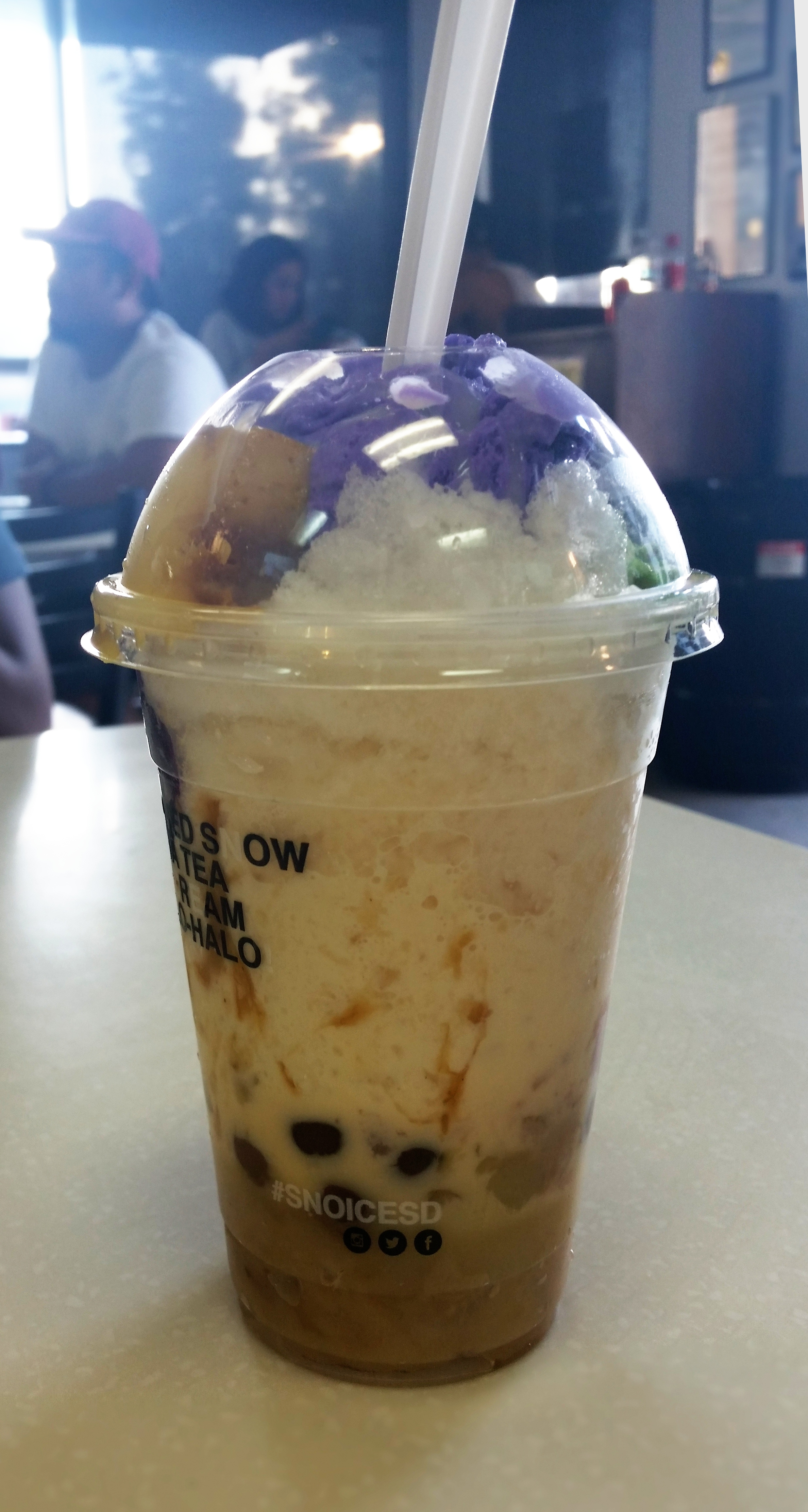 Halo-halo, also spelled ''haluhalo'', Filipino for "mixed", is a popular cold dessert in the
Halo-halo, also spelled ''haluhalo'', Filipino for "mixed", is a popular cold dessert in the 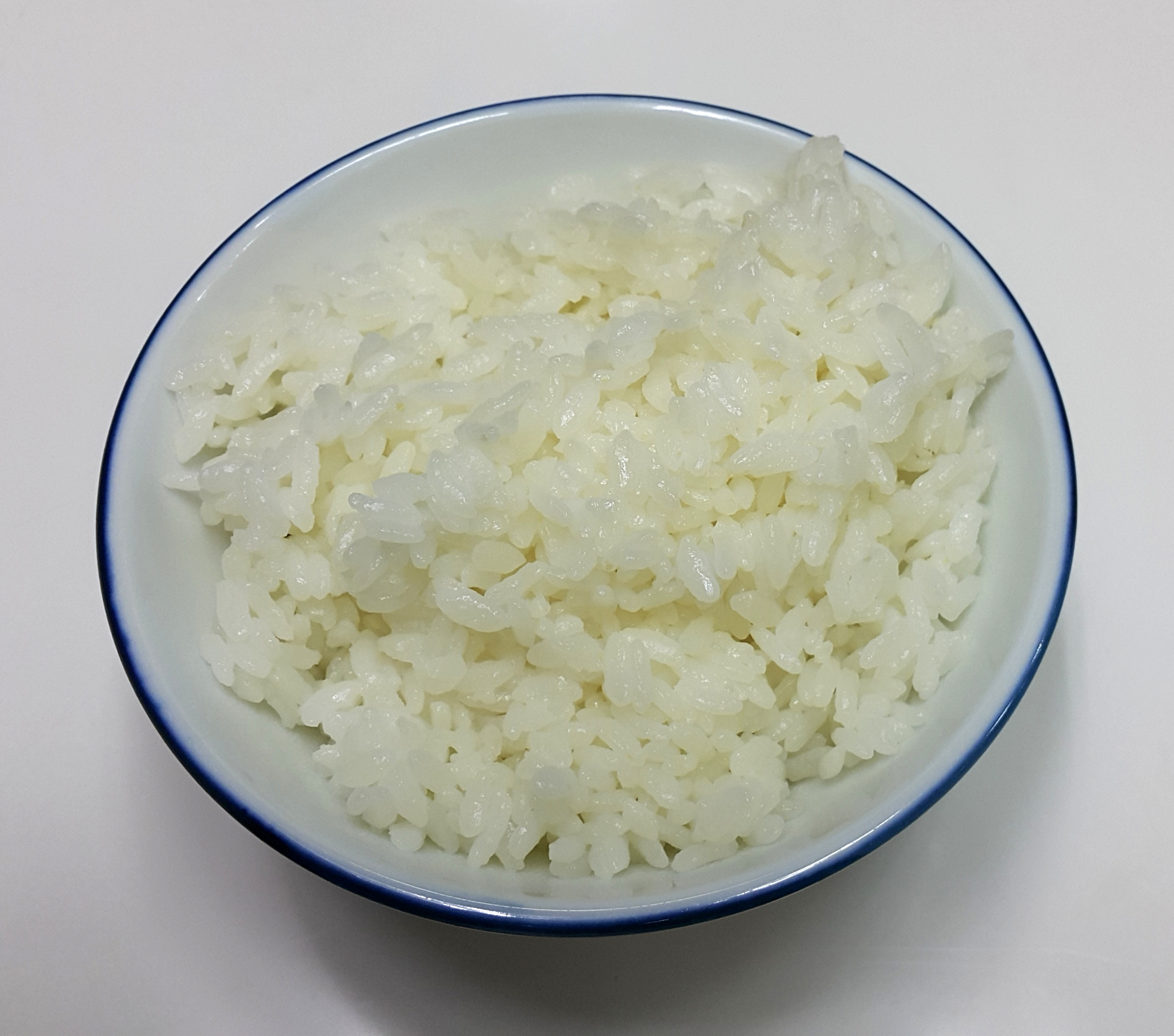 Some authors specifically attribute ''halo-halo'' to the 1920s or 1930s Japanese migrants in the
Some authors specifically attribute ''halo-halo'' to the 1920s or 1930s Japanese migrants in the  Odong, also called pancit odong, is a Visayan noodle soup made with noodles, canned smoked sardines ('' tinapa'') in tomato sauce, bottle gourd (), loofah (), chayote, ginger, garlic, red onions, and various other vegetables. It is garnished and spiced with black pepper, scallions, toasted garlic, calamansi, or labuyo chilis. The dish is usually prepared as a soup, but it can also be cooked with minimal water, in which case, it is known as odong guisado.
It is a common simple and cheap meal in
Odong, also called pancit odong, is a Visayan noodle soup made with noodles, canned smoked sardines ('' tinapa'') in tomato sauce, bottle gourd (), loofah (), chayote, ginger, garlic, red onions, and various other vegetables. It is garnished and spiced with black pepper, scallions, toasted garlic, calamansi, or labuyo chilis. The dish is usually prepared as a soup, but it can also be cooked with minimal water, in which case, it is known as odong guisado.
It is a common simple and cheap meal in Arab influence via indirect trade
The Arab influence on Filipino cuisine is relatively minor. Historically, Arabs influence arrived via India to Indonesia and the Philippines. In the earlier days, Arabs traded with Indians, who in turn traded with Southeast Asia. In the later era, with advancement of sea navigation, Arabs also started to trade directly with the Philippines.American colonial and American influence
After the Spanish–American War in 1899, the United States controlled the Philippines due to the Treaty of Paris. US soldiers introduced Filipinos to hot dogs, hamburgers, fried chicken, andCharacteristics
Contrasting combination of base tastes
Filipino cuisine centres around the combination of sweet (''tamis''), sour (''asim''), and salty (''alat''), although in Bicol Region, Bicol, the Cordillera Administrative Region, Cordilleras and among Moro people, Muslim Filipinos, spicy (''anghang'') is a base of cooking flavor. Counterpoint is a feature in Filipino cuisine which normally comes in a pairing of something sweet with something salty. Examples include: ''champorado'' (a sweet cocoa rice porridge), being paired with ''Daing, tuyo'' (salted, sun-dried fish); ''dinuguan'' (a savory stew made of pig's blood and innards), paired with '' puto'' (sweet, steamed rice cakes); unripe fruits such as green mangoes (which are only slightly sweet but very sour), are eaten dipped in salt or ''bagoong''; the use of cheese (which is salty-sweet) in sweetcakes (such as ''Cooking and serving
Cooking and eating in the Philippines has traditionally been an informal and communal affair centered around the family kitchen. Food tends to be served all at once and not in courses.Eating methods
 Like many of their Southeast Asian counterparts Filipinos do not eat with chopsticks. The traditional way of eating is with the hands, especially dry dishes such as ''inihaw'' or ''prito''. The diner will take a bite of the main dish, then eat rice pressed together with their fingers. This practice, known as ''kamayan'' (using the washed left hand for picking the centralized food and the right hand for bringing food to the mouth), is rarely seen in urbanized areas. However, Filipinos tend to feel the spirit of ''kamayan'' when eating amidst nature during out-of-town trips, beach vacations, and town fiestas.
''Kamayan'' is also used in the "boodle fight" concept, a style of dining popularized by the Philippine Army which utilizes banana leaves spread out on the table as the main serving platter, upon which is laid out portions of rice and a variety of Filipino dishes for friendly, filial or communal feasting. The use of spoons and forks, however, is still the norm.
Like many of their Southeast Asian counterparts Filipinos do not eat with chopsticks. The traditional way of eating is with the hands, especially dry dishes such as ''inihaw'' or ''prito''. The diner will take a bite of the main dish, then eat rice pressed together with their fingers. This practice, known as ''kamayan'' (using the washed left hand for picking the centralized food and the right hand for bringing food to the mouth), is rarely seen in urbanized areas. However, Filipinos tend to feel the spirit of ''kamayan'' when eating amidst nature during out-of-town trips, beach vacations, and town fiestas.
''Kamayan'' is also used in the "boodle fight" concept, a style of dining popularized by the Philippine Army which utilizes banana leaves spread out on the table as the main serving platter, upon which is laid out portions of rice and a variety of Filipino dishes for friendly, filial or communal feasting. The use of spoons and forks, however, is still the norm.
Changes in eating method
During the Spanish occupation, which yielded Western influences, Filipinos ate with the paired utensils of spoon and fork. The knife was not used as in other countries, because Spain prohibited them to have knives. Filipinos use the side of the spoon, to "cut" the food. Due to Western influence, food is often eaten using flatware—forks, knives, spoons—but the primary pairing of utensils used at a Filipino dining table is that of spoon and fork, not knife and fork.Native ingredients
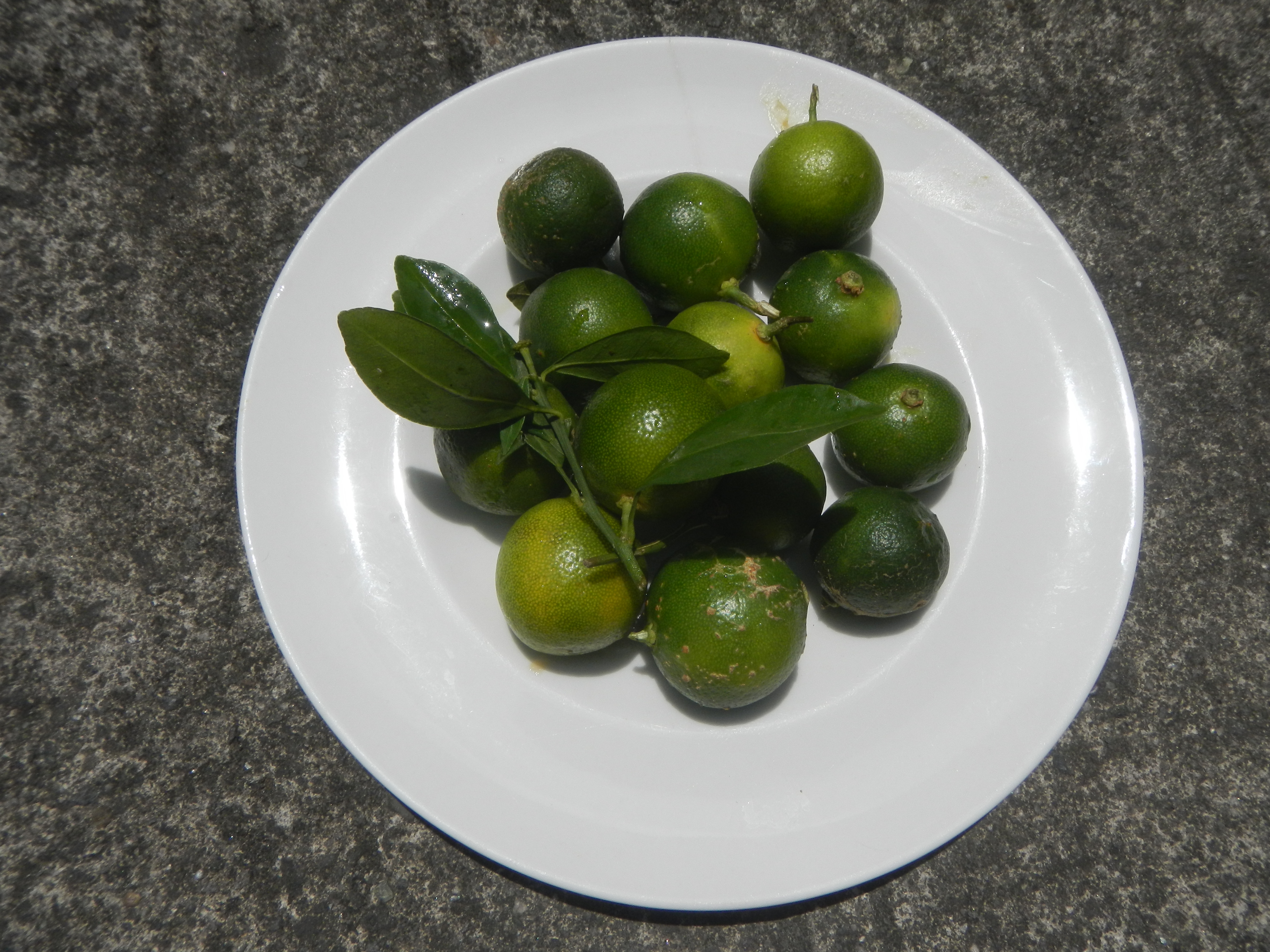
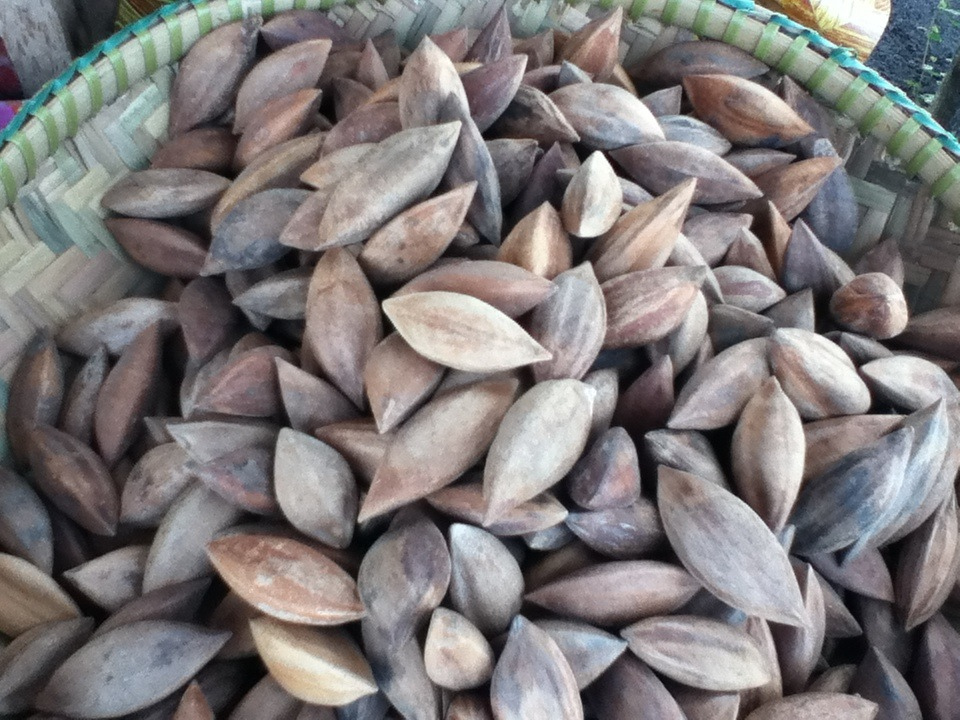
 Filipino cuisine has a variety of native ingredients used. The biota that developed yielded a particular landscape and in turn gave the place local ingredients that enhanced flavors to the dishes. Kalamansi is the more known of those ingredients, it is a fruit that belongs to the genus citrus. It is mostly used due to the sourness it gives to a dish. Another is the tabon-tabon, a tropical fruit which were used by pre-colonial Filipinos as anti-bacterial ingredient especially in Kinilaw dishes.
The country also cultivates different type of nuts and one of them is the pili nut, of which the Philippines is the only known exporter of edible varieties. It is usually made as a merienda or is incorporated in other desserts to enhance the flavor due to the milky texture it gives off as it melts in the mouth.
Vinegar is a common ingredient. ''Philippine adobo, Adobo'' is popular not solely for its simplicity and ease of preparation, but also for its ability to be stored for days without spoiling, and even improve in flavor with a day or two of storage. ''Tinapa'' is a smoke-cured fish while ''tuyo'', ''daing'', and ''dangit'' are corned, sun-dried fish popular because they can last for weeks without spoiling, even without refrigeration.
Filipino cuisine has a variety of native ingredients used. The biota that developed yielded a particular landscape and in turn gave the place local ingredients that enhanced flavors to the dishes. Kalamansi is the more known of those ingredients, it is a fruit that belongs to the genus citrus. It is mostly used due to the sourness it gives to a dish. Another is the tabon-tabon, a tropical fruit which were used by pre-colonial Filipinos as anti-bacterial ingredient especially in Kinilaw dishes.
The country also cultivates different type of nuts and one of them is the pili nut, of which the Philippines is the only known exporter of edible varieties. It is usually made as a merienda or is incorporated in other desserts to enhance the flavor due to the milky texture it gives off as it melts in the mouth.
Vinegar is a common ingredient. ''Philippine adobo, Adobo'' is popular not solely for its simplicity and ease of preparation, but also for its ability to be stored for days without spoiling, and even improve in flavor with a day or two of storage. ''Tinapa'' is a smoke-cured fish while ''tuyo'', ''daing'', and ''dangit'' are corned, sun-dried fish popular because they can last for weeks without spoiling, even without refrigeration.
Food for the specific occasions
Meals of the day
Filipinos traditionally eat three main meals a day: ''wikt:almusal, almusal'' or ''wikt:agahan, agahan'' (breakfast), ''wikt:tanghalian, tanghalían'' (lunch), and ''wikt:hapunan, hapunan'' (dinner) plus morning and an afternoon snack called ''wikt:meryenda, meryenda'' (also called ''minandál'' or ''minindál'').''Almusal'' (breakfast)
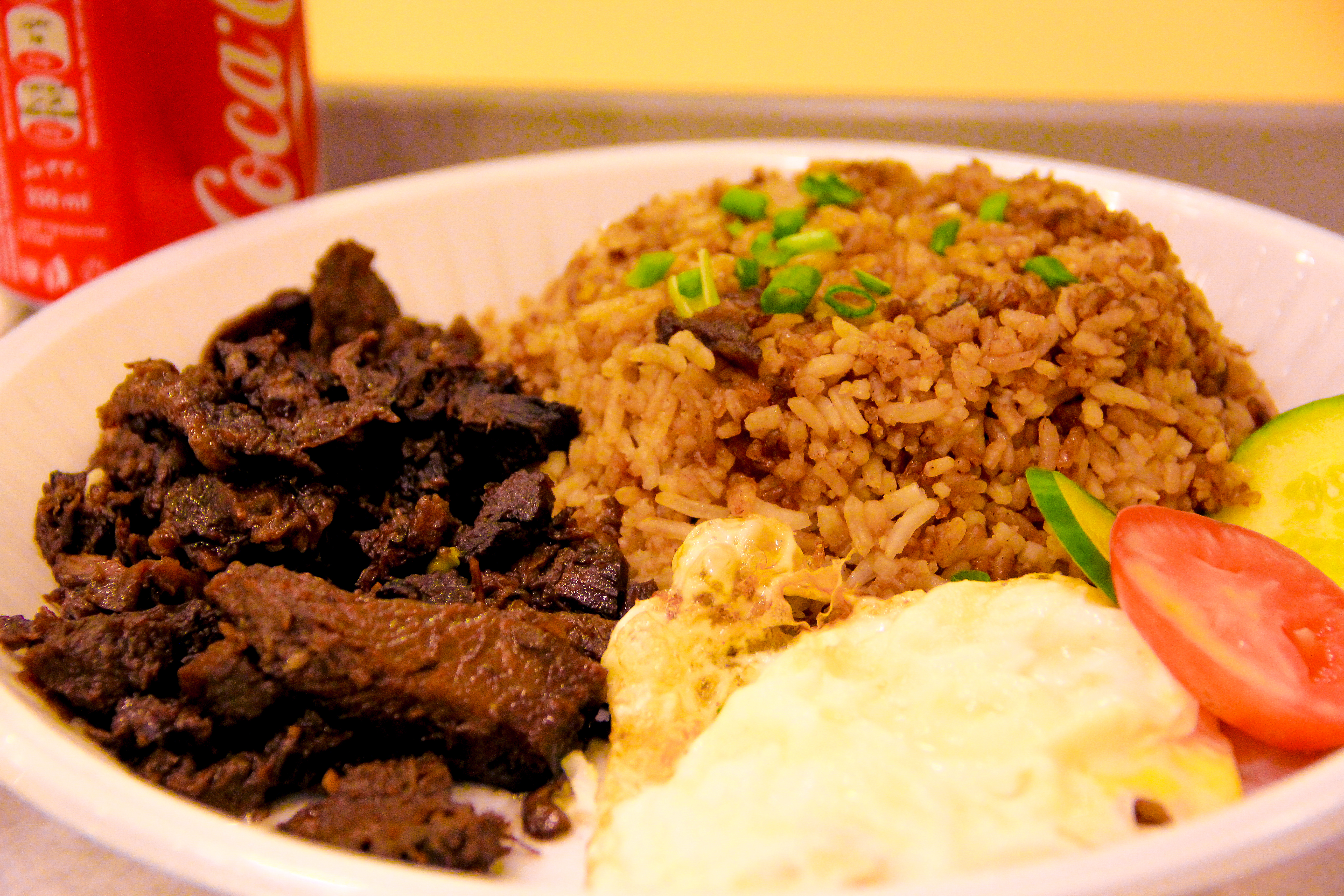 A traditional Filipino breakfast might include ''pandesal'' (small bread rolls), ''kesong puti'' (fresh, unripened, white Filipino cheese, traditionally made from carabao's milk) ''champorado'' (chocolate rice porridge), ''Silog (dish), silog'' which is ''sinangag'' (fried rice, garlic fried rice) or sinaing, with fried egg and meat—such as ''
A traditional Filipino breakfast might include ''pandesal'' (small bread rolls), ''kesong puti'' (fresh, unripened, white Filipino cheese, traditionally made from carabao's milk) ''champorado'' (chocolate rice porridge), ''Silog (dish), silog'' which is ''sinangag'' (fried rice, garlic fried rice) or sinaing, with fried egg and meat—such as '' Certain portmanteaus in Filipino have come into use to describe popular combinations of items in a Filipino breakfast. An example of such a combination order is ''kankamtuy'': an order of ''kanin'' (rice), ''kamatis'' (tomatoes) and ''tuyo'' (dried fish). Another is ''tapsi'': an order of ''tapa'' and ''sinangág'' or ''sinaing''. Other examples include variations using a ''Silog (dish), silog'' suffix, usually some kind of meat served with ''sinangág'' or ''sinaing'', and ''itlog'' (egg). The three most commonly seen ''silogs'' are ''tapsilog'' (having ''tapa'' as the meat portion), (having tocino as the meat portion), and (having longganisa as the meat portion). Other ''silogs'' include ''hotsilog'' (with a hot dog), ''bangsilog'' (with milkfish, ''bangus'' (milkfish)), ''dangsilog'' (with rabbitfish, ''danggit'' (rabbitfish)), ''spamsilog'' (with spam (food), spam), ''adosilog'' (with adobo), ''chosilog'' (with chorizo), ''chiksilog'' (with chicken), ''cornsilog'' (with corned beef), and ''litsilog'' (with lechon, lechon/litson). ''Pankaplog'' is slang for a breakfast consisting of ''pandesal'', ''Kape Barako, kape'' (coffee), and ''itlog'' (egg), it is also a double entendre meaning to fondle breasts. An establishment that specializes in such meals is called a ''tapsihan'' or ''tapsilugan''.
Certain portmanteaus in Filipino have come into use to describe popular combinations of items in a Filipino breakfast. An example of such a combination order is ''kankamtuy'': an order of ''kanin'' (rice), ''kamatis'' (tomatoes) and ''tuyo'' (dried fish). Another is ''tapsi'': an order of ''tapa'' and ''sinangág'' or ''sinaing''. Other examples include variations using a ''Silog (dish), silog'' suffix, usually some kind of meat served with ''sinangág'' or ''sinaing'', and ''itlog'' (egg). The three most commonly seen ''silogs'' are ''tapsilog'' (having ''tapa'' as the meat portion), (having tocino as the meat portion), and (having longganisa as the meat portion). Other ''silogs'' include ''hotsilog'' (with a hot dog), ''bangsilog'' (with milkfish, ''bangus'' (milkfish)), ''dangsilog'' (with rabbitfish, ''danggit'' (rabbitfish)), ''spamsilog'' (with spam (food), spam), ''adosilog'' (with adobo), ''chosilog'' (with chorizo), ''chiksilog'' (with chicken), ''cornsilog'' (with corned beef), and ''litsilog'' (with lechon, lechon/litson). ''Pankaplog'' is slang for a breakfast consisting of ''pandesal'', ''Kape Barako, kape'' (coffee), and ''itlog'' (egg), it is also a double entendre meaning to fondle breasts. An establishment that specializes in such meals is called a ''tapsihan'' or ''tapsilugan''.
''Tanghalian'' (lunch)
A typical Filipino lunch is composed of a food variant (or two for some) and rice, sometimes with soup. Whether grilled, stewed, or fried, rice is eaten with everything. Due to the tropical climate of the Philippines, the preference is to serve ice cold water, juices, or soft drinks with meals.''Hapunan'' (supper)
Dinner, while still the main meal, is smaller than in other countries. Typical meals in a Filipino dinner are usually leftover meals from lunch. Filipino dinner is usually served in the time period between 6-8 pm, though dinner is served much more early in the countryside.Snacks
Merienda light afternoon meal
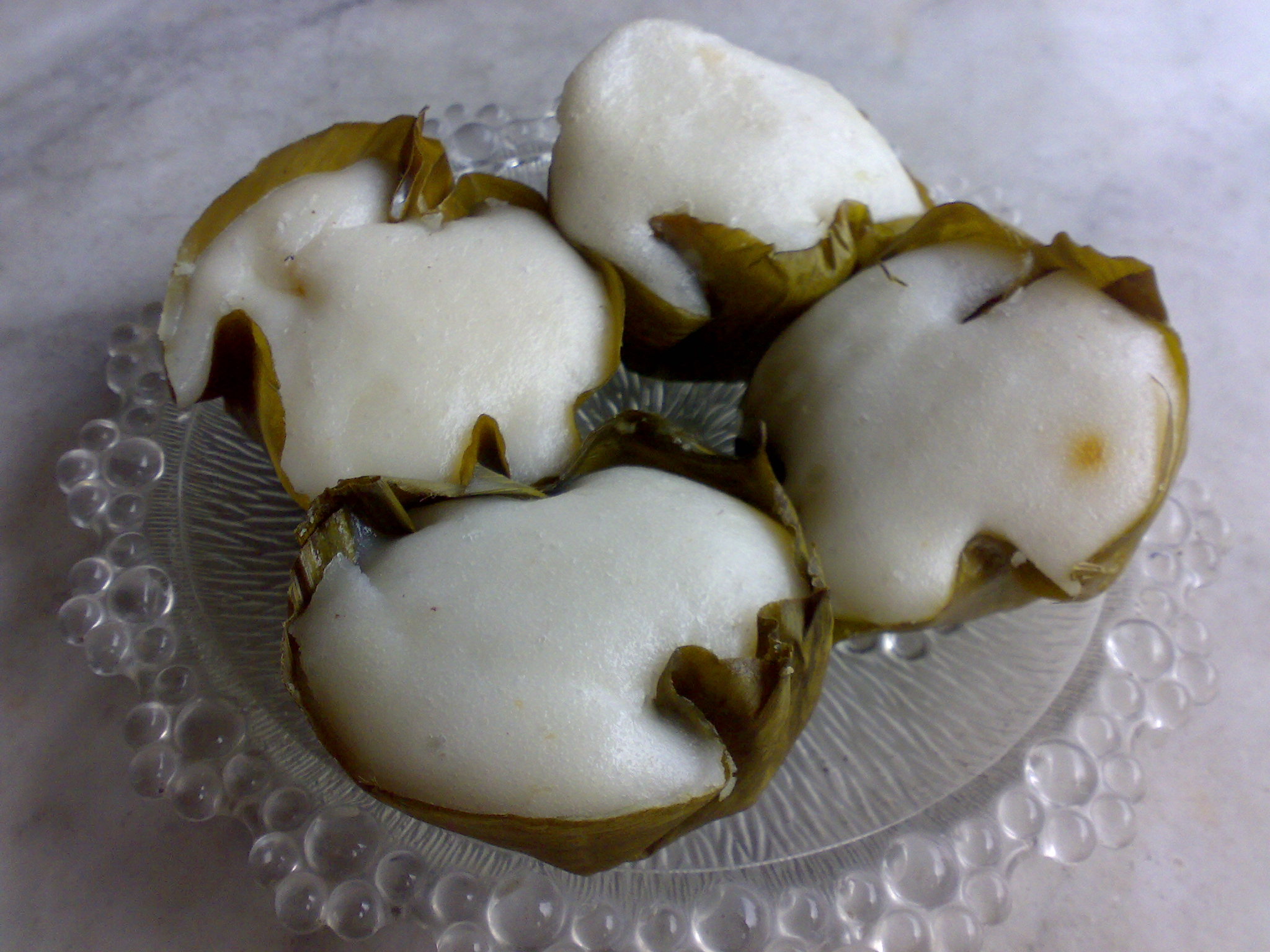
 ''Merienda'' is taken from the Spanish, and is a light meal or snack especially in the afternoon, similar to the concept of afternoon tea (meal), tea. If the meal is taken close to dinner, it is called ''merienda cena'', and may be served instead of dinner.
Filipinos have a number of options to take with ''kapé'', which is the Filipino pronunciation of café (coffee): breads and pastries like ''pandesal'', ''Ensaimada, ensaymada'' (buttery ''brioche'' covered in grated cheese and sugar), ''Bakpia, hopia'' (pastries similar to mooncakes filled with mung bean paste) and empanada (savoury, meat-filled pasty, pasties). Also popular are ''kakanín'', or traditional pastries made from sticky rice like ''kutsinta'', ''sapin-sapin'' (multicoloured, layered pastry), ''palitaw'', ''biko (food), biko'', ''Suman (food), suman'', ''Bibingka'', and ''pitsi-pitsî'' (served with desiccated coconut).
Savoury dishes often eaten during ''merienda'' include '' pancit canton'' (stir-fried noodles), ''palabok'' (rice noodles with a shrimp-based sauce), ''Tokwa at baboy, tokwa't baboy'' (fried tofu with boiled pork ears in a garlic-flavored soy sauce and vinegar dressing), and ''dinuguan'' (a spicy stew made of pork blood), which is often served with '' puto'' (steamed rice flour cakes).
Dim sum and dumplings, brought to the islands by Min Chinese speakers, Fujianese migrants, have been given a Filipino touch and are also popular ''merienda'' fare. Street food, such as squid balls and fish balls, are often skewered on bamboo sticks and consumed with soy sauce and the sour juice of the calamondin as condiments.
''Merienda'' is taken from the Spanish, and is a light meal or snack especially in the afternoon, similar to the concept of afternoon tea (meal), tea. If the meal is taken close to dinner, it is called ''merienda cena'', and may be served instead of dinner.
Filipinos have a number of options to take with ''kapé'', which is the Filipino pronunciation of café (coffee): breads and pastries like ''pandesal'', ''Ensaimada, ensaymada'' (buttery ''brioche'' covered in grated cheese and sugar), ''Bakpia, hopia'' (pastries similar to mooncakes filled with mung bean paste) and empanada (savoury, meat-filled pasty, pasties). Also popular are ''kakanín'', or traditional pastries made from sticky rice like ''kutsinta'', ''sapin-sapin'' (multicoloured, layered pastry), ''palitaw'', ''biko (food), biko'', ''Suman (food), suman'', ''Bibingka'', and ''pitsi-pitsî'' (served with desiccated coconut).
Savoury dishes often eaten during ''merienda'' include '' pancit canton'' (stir-fried noodles), ''palabok'' (rice noodles with a shrimp-based sauce), ''Tokwa at baboy, tokwa't baboy'' (fried tofu with boiled pork ears in a garlic-flavored soy sauce and vinegar dressing), and ''dinuguan'' (a spicy stew made of pork blood), which is often served with '' puto'' (steamed rice flour cakes).
Dim sum and dumplings, brought to the islands by Min Chinese speakers, Fujianese migrants, have been given a Filipino touch and are also popular ''merienda'' fare. Street food, such as squid balls and fish balls, are often skewered on bamboo sticks and consumed with soy sauce and the sour juice of the calamondin as condiments.
Pulutan accompaniments snack for drinks

 ''Pulutan'' (from the Filipino word which literally means "to pick up") is a term roughly analogous to the English term "finger food" or Spanish Tapas. Originally, it was a snack accompanied with liquor or beer but has found its way into Filipino cuisine as appetizers or, in some cases, main dishes, as in the case of ''sisig''.
''Pulutan'' (from the Filipino word which literally means "to pick up") is a term roughly analogous to the English term "finger food" or Spanish Tapas. Originally, it was a snack accompanied with liquor or beer but has found its way into Filipino cuisine as appetizers or, in some cases, main dishes, as in the case of ''sisig''.
 Deep fried ''pulutan'' include ''chicharrón, chicharon'' (less commonly spelled ''tsitsaron''), pork rinds that have been boiled and then twice fried, the second frying gives the crunchiness and golden color; ''chicharong bituka'', pig intestines that have been deep fried to a crisp; ''chicharong bulaklak'', similar to ''chicharong bituka'' it is made from mesenteries of pig intestines and has an appearance roughly resembling a flower, hence the name; and , chicken skin that has been deep Frying, fried until crisp. Other examples of deep fried pulutan are crispy crablets, crispy frog legs, or fish skin cracklings, and or deep fried pork fat (also known as ''pinaigi'').
Examples of grilled foods include: ''isaw,'' or chicken or pig intestines skewered and then grilled; ''Inihaw na tenga'', pig ears that have been skewered and then grilled; ''pork barbecue,'' skewered pork marinated in a sweet soy-garlic blend and then grilled; ''betamax'', salted solidified pork or chicken blood which is then skewered and lightly grilled; ''adidas'' which is Grilling, grilled or sautéed chicken feet. There is also ''sisig'', a popular ''pulutan'' made from the pig's cheek skin, ears, and liver that is initially boiled, then charcoal grilled and afterwards minced and cooked with chopped onions, chillies, and spices.
Smaller snacks such as ''mani'' (
Deep fried ''pulutan'' include ''chicharrón, chicharon'' (less commonly spelled ''tsitsaron''), pork rinds that have been boiled and then twice fried, the second frying gives the crunchiness and golden color; ''chicharong bituka'', pig intestines that have been deep fried to a crisp; ''chicharong bulaklak'', similar to ''chicharong bituka'' it is made from mesenteries of pig intestines and has an appearance roughly resembling a flower, hence the name; and , chicken skin that has been deep Frying, fried until crisp. Other examples of deep fried pulutan are crispy crablets, crispy frog legs, or fish skin cracklings, and or deep fried pork fat (also known as ''pinaigi'').
Examples of grilled foods include: ''isaw,'' or chicken or pig intestines skewered and then grilled; ''Inihaw na tenga'', pig ears that have been skewered and then grilled; ''pork barbecue,'' skewered pork marinated in a sweet soy-garlic blend and then grilled; ''betamax'', salted solidified pork or chicken blood which is then skewered and lightly grilled; ''adidas'' which is Grilling, grilled or sautéed chicken feet. There is also ''sisig'', a popular ''pulutan'' made from the pig's cheek skin, ears, and liver that is initially boiled, then charcoal grilled and afterwards minced and cooked with chopped onions, chillies, and spices.
Smaller snacks such as ''mani'' (Fiesta food
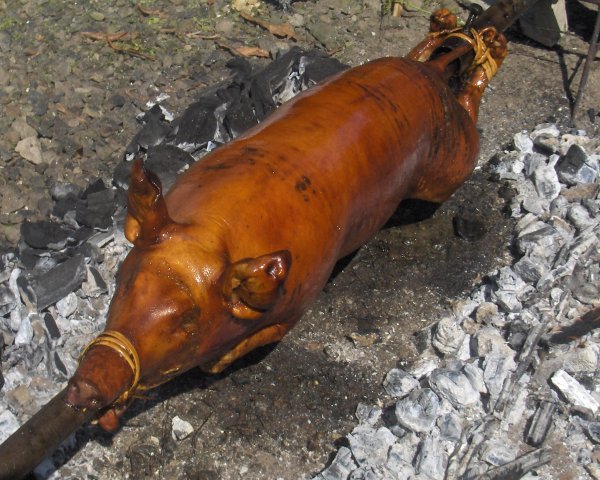 For festive occasions, people band together and prepare more sophisticated dishes. Tables are often laden with expensive and labor-intensive treats requiring hours of preparation. In Filipino celebrations, ''lechon'' (less commonly spelled ''litson'') serves as the centerpiece of the dinner table. It is usually a whole roasted pig, but suckling pigs (''lechonillo'', or ''lechon de leche'') or cattle calves () can also be prepared in place of the popular adult pig. It is typically served with ''lechon'' sauce, which is traditionally made from the roasted pig's liver. Other dishes include ''hamonado'' (honey-cured beef, pork or chicken), ''relleno'' (stuffed chicken or milkfish), '' mechado'', ''afritada'', ''caldereta'', ''puchero'', paella, ''Menudo (stew), menudo'', ''morcon'', ''embutido'' (referring to a meatloaf dish, not a sausage as understood elsewhere), ''suman'' (a savory rice and coconut milk concoction steamed in leaves such as banana), and '' pancit canton''. The table may also be have various sweets and pastries such as ''Leche Flan, leche flan'', ''
For festive occasions, people band together and prepare more sophisticated dishes. Tables are often laden with expensive and labor-intensive treats requiring hours of preparation. In Filipino celebrations, ''lechon'' (less commonly spelled ''litson'') serves as the centerpiece of the dinner table. It is usually a whole roasted pig, but suckling pigs (''lechonillo'', or ''lechon de leche'') or cattle calves () can also be prepared in place of the popular adult pig. It is typically served with ''lechon'' sauce, which is traditionally made from the roasted pig's liver. Other dishes include ''hamonado'' (honey-cured beef, pork or chicken), ''relleno'' (stuffed chicken or milkfish), '' mechado'', ''afritada'', ''caldereta'', ''puchero'', paella, ''Menudo (stew), menudo'', ''morcon'', ''embutido'' (referring to a meatloaf dish, not a sausage as understood elsewhere), ''suman'' (a savory rice and coconut milk concoction steamed in leaves such as banana), and '' pancit canton''. The table may also be have various sweets and pastries such as ''Leche Flan, leche flan'', ''Type of food
Common food
Filipino food is widely shaped by individual traditions and customs, and the same dish may and will differ between households.Staples
As in most Asian countries, the staple food in the Philippines is rice. It is most often steamed and always served with meat, fish and vegetable dishes. Leftover rice is often fried with garlic to make '' sinangag'', which is usually served at breakfast together with a fried egg and Curing (food preservation), cured meat or sausages. Rice is often enjoyed with the sauce or broth from the main dishes. In some regions, rice is mixed with salt, condensed milk, cocoa, or coffee. Rice flour is used in making sweets, cakes and other pastries. Sticky rice with cocoa, also called ''champorado'' is also a common dish served with ''daing'' (dried herring). Rice and coconuts as staples throughout the archipelago as in the rest of Southeast Asia meant similar or adopted dishes and methods based on these crops. Some of these are evident in the infusion of coconut milk particularly in the renowned ''laing (food), laing'' and ''sinilihan'' (popularized as Bicol Express) of Bikol. Other regional variants of stews or soups commonly tagged as or "with coconut milk" also abound Filipino kitchens and food establishments. A dish from the Visayas simmered in coconut water, ideally in bamboo, is the ''binakol'' usually with chicken as the main ingredient. A variety of fruits and vegetables are often used in cooking. Cooking banana, Plantains (also called ''Saba Banana, saba'' in Filipino), kalamansi, guavas (''bayabas''), mangoes, papayas, and pineapples lend a distinctly tropical flair in many dishes, but mainstay green leafy vegetables like water spinach (''kangkong''), Chinese cabbage (''petsay''), Napa cabbage (''petsay wombok''), cabbage (''repolyo'') and other vegetables like eggplants (''talong'') and yard-long beans (''sitaw'') are just as commonly used. Coconuts are ubiquitous. Coconut meat is often used in desserts, coconut milk (''kakang gata'') in sauces, and coconut oil for frying. Abundant harvests of root crops like potatoes, carrots, taro (''gabi''), cassava (''kamoteng kahoy''), purple yam (''
A variety of fruits and vegetables are often used in cooking. Cooking banana, Plantains (also called ''Saba Banana, saba'' in Filipino), kalamansi, guavas (''bayabas''), mangoes, papayas, and pineapples lend a distinctly tropical flair in many dishes, but mainstay green leafy vegetables like water spinach (''kangkong''), Chinese cabbage (''petsay''), Napa cabbage (''petsay wombok''), cabbage (''repolyo'') and other vegetables like eggplants (''talong'') and yard-long beans (''sitaw'') are just as commonly used. Coconuts are ubiquitous. Coconut meat is often used in desserts, coconut milk (''kakang gata'') in sauces, and coconut oil for frying. Abundant harvests of root crops like potatoes, carrots, taro (''gabi''), cassava (''kamoteng kahoy''), purple yam (''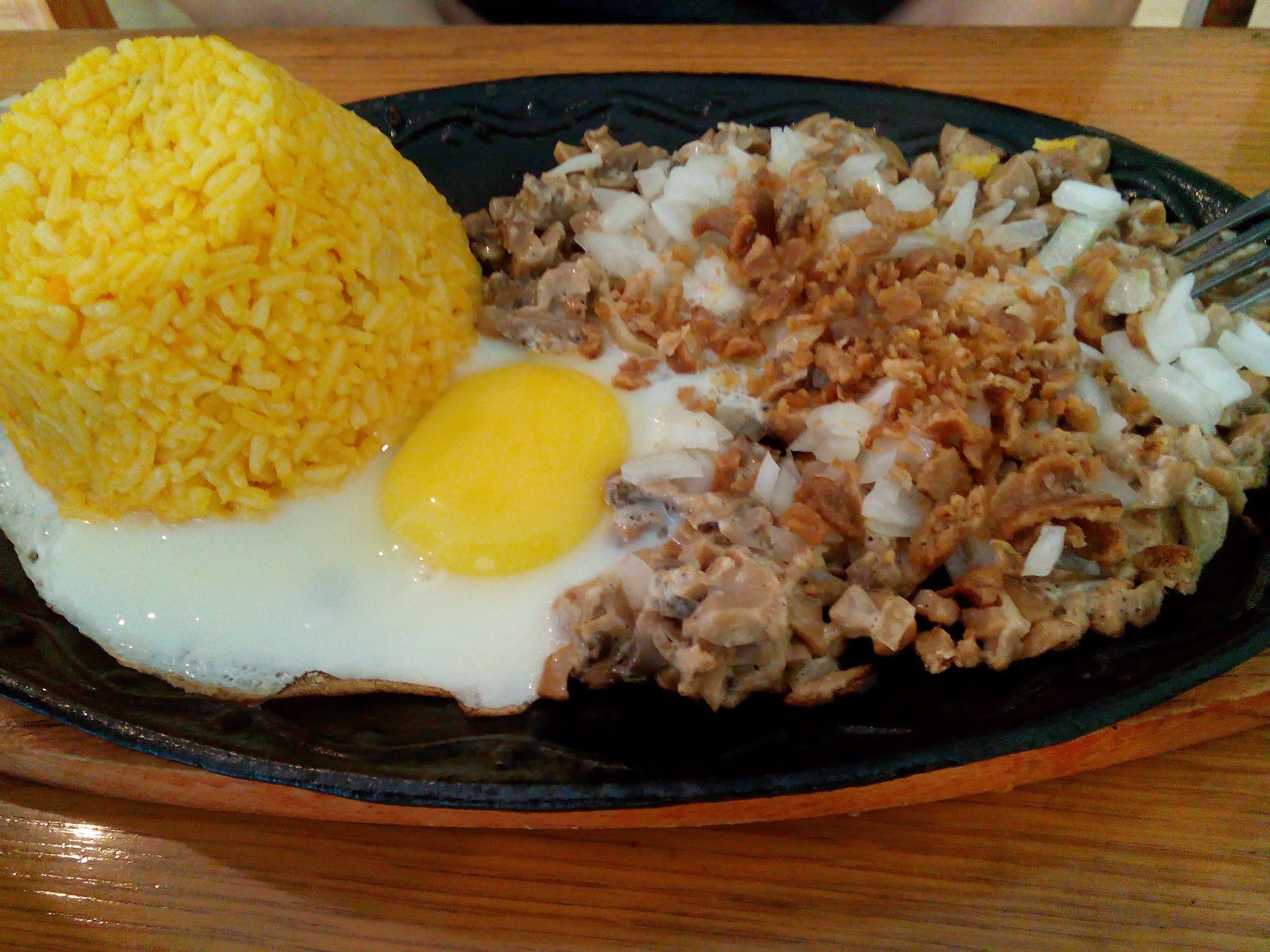 Meat staples include chicken, pork, beef, and Fish as food, fish. Seafood is popular as a result of the bodies of water surrounding the archipelago. Popular catches include tilapia, catfish (''hito''), milkfish (''bangus''), grouper (''lapu-lapu''), shrimp (''hipon''), prawns (''sugpo''), mackerel (''galunggong'', ''hasa-hasa''), swordfish (''isdang-ispada''), oysters (''talaba''), mussels (''tahong''), clams (''halaan'' and ''tulya''), large and small crabs (''alimango'' and ''alimasag'' respectively), game fish, sablefish, tuna, cod (''bakalaw''), Indo-Pacific blue marlin, blue marlin, and squid/cuttlefish (both called ''pusit''). Also popular are seaweeds (''damong dagat''), abalone, and eel (''igat'').
The most common way of having fish is to have it salted, pan-fried or deep-fried, and then eaten as a simple meal with rice and vegetables. It may also be cooked in a sour broth of tomatoes or tamarind as in ''pangat'', prepared with vegetables and a souring agent to make '' sinigang'', simmered in vinegar and peppers to make ''paksiw'', or roasted over hot charcoal
Meat staples include chicken, pork, beef, and Fish as food, fish. Seafood is popular as a result of the bodies of water surrounding the archipelago. Popular catches include tilapia, catfish (''hito''), milkfish (''bangus''), grouper (''lapu-lapu''), shrimp (''hipon''), prawns (''sugpo''), mackerel (''galunggong'', ''hasa-hasa''), swordfish (''isdang-ispada''), oysters (''talaba''), mussels (''tahong''), clams (''halaan'' and ''tulya''), large and small crabs (''alimango'' and ''alimasag'' respectively), game fish, sablefish, tuna, cod (''bakalaw''), Indo-Pacific blue marlin, blue marlin, and squid/cuttlefish (both called ''pusit''). Also popular are seaweeds (''damong dagat''), abalone, and eel (''igat'').
The most common way of having fish is to have it salted, pan-fried or deep-fried, and then eaten as a simple meal with rice and vegetables. It may also be cooked in a sour broth of tomatoes or tamarind as in ''pangat'', prepared with vegetables and a souring agent to make '' sinigang'', simmered in vinegar and peppers to make ''paksiw'', or roasted over hot charcoal or wood (''grilling, inihaw''). Other preparations include ''escabeche'' (sweet and sour), ''relleno'' (deboned and stuffed), or "kinilaw" (similar to ceviche; marinated in vinegar or kalamansi). Fish can be preserved by being smoked ('' tinapa'') or sun-dried (''tuyo'' or ''daing'').
Food is often served with various dipping sauces. Fried food is often dipped either in vinegar with onions, soy sauce with juice squeezed from ''Calamansi, Kalamansi'' (Philippine lime or ''calamansi''). ''Patis'' (fish sauce) may be mixed with ''kalamansi'' as dipping sauce for most seafood or mixed with a stew called nilaga. Fish sauce, fish paste (''Bagoong terong, bagoong''), shrimp paste (''bagoong alamang'') and crushed ginger root (''luya'') are condiments that are often added to dishes during the cooking process or when served.
or wood (''grilling, inihaw''). Other preparations include ''escabeche'' (sweet and sour), ''relleno'' (deboned and stuffed), or "kinilaw" (similar to ceviche; marinated in vinegar or kalamansi). Fish can be preserved by being smoked ('' tinapa'') or sun-dried (''tuyo'' or ''daing'').
Food is often served with various dipping sauces. Fried food is often dipped either in vinegar with onions, soy sauce with juice squeezed from ''Calamansi, Kalamansi'' (Philippine lime or ''calamansi''). ''Patis'' (fish sauce) may be mixed with ''kalamansi'' as dipping sauce for most seafood or mixed with a stew called nilaga. Fish sauce, fish paste (''Bagoong terong, bagoong''), shrimp paste (''bagoong alamang'') and crushed ginger root (''luya'') are condiments that are often added to dishes during the cooking process or when served.
Main dishes
 ''Philippine adobo, Adobo'' is one of the most popular Filipino dishes and is considered unofficially by many as the national dish. It usually consists of pork or chicken, sometimes both, stewed or braised in a sauce usually made from vinegar, cooking oil, garlic, bay leaf, peppercorns, and soy sauce. It can also be prepared "dry" by cooking out the liquid and concentrating the flavor. ''Bistek'', also known as "Filipino beef steak," consists of thinly sliced beef marinated in soy sauce and calamansi and then fried in a skillet that is typically served with onions.
Some well-known stews are '' kare-kare'' and ''dinuguan''. In ''kare-kare'', also known as "peanut stew", oxtail or ox tripe is the main ingredient and is cooked with vegetables in a peanut-based preparation. It is typically served with ''bagoong'' (fermented shrimp paste). In ''dinuguan'', pig's blood, entrails, and meat are cooked with vinegar and seasoned with chili peppers, usually ''siling mahaba''.
''Philippine adobo, Adobo'' is one of the most popular Filipino dishes and is considered unofficially by many as the national dish. It usually consists of pork or chicken, sometimes both, stewed or braised in a sauce usually made from vinegar, cooking oil, garlic, bay leaf, peppercorns, and soy sauce. It can also be prepared "dry" by cooking out the liquid and concentrating the flavor. ''Bistek'', also known as "Filipino beef steak," consists of thinly sliced beef marinated in soy sauce and calamansi and then fried in a skillet that is typically served with onions.
Some well-known stews are '' kare-kare'' and ''dinuguan''. In ''kare-kare'', also known as "peanut stew", oxtail or ox tripe is the main ingredient and is cooked with vegetables in a peanut-based preparation. It is typically served with ''bagoong'' (fermented shrimp paste). In ''dinuguan'', pig's blood, entrails, and meat are cooked with vinegar and seasoned with chili peppers, usually ''siling mahaba''.
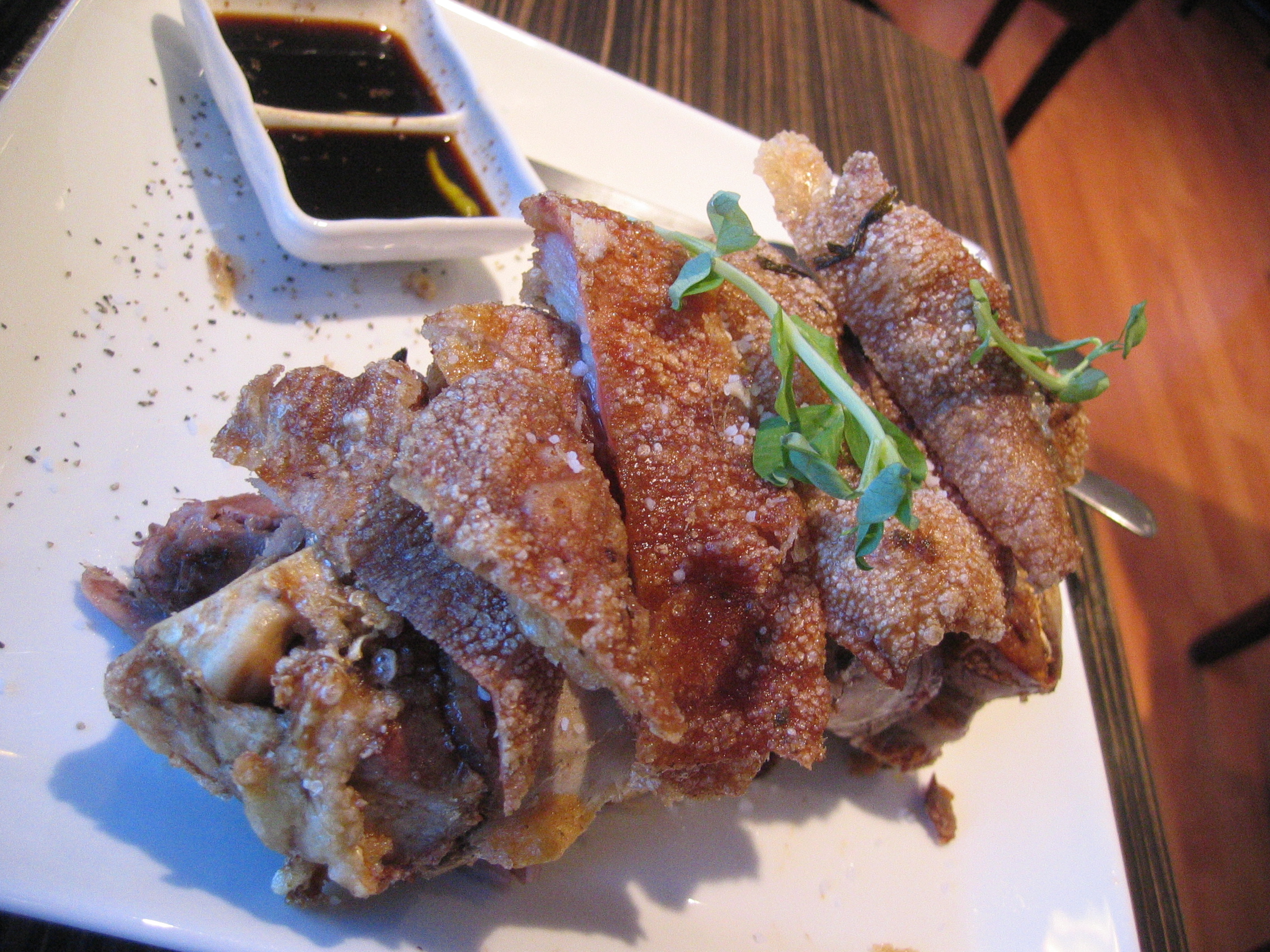
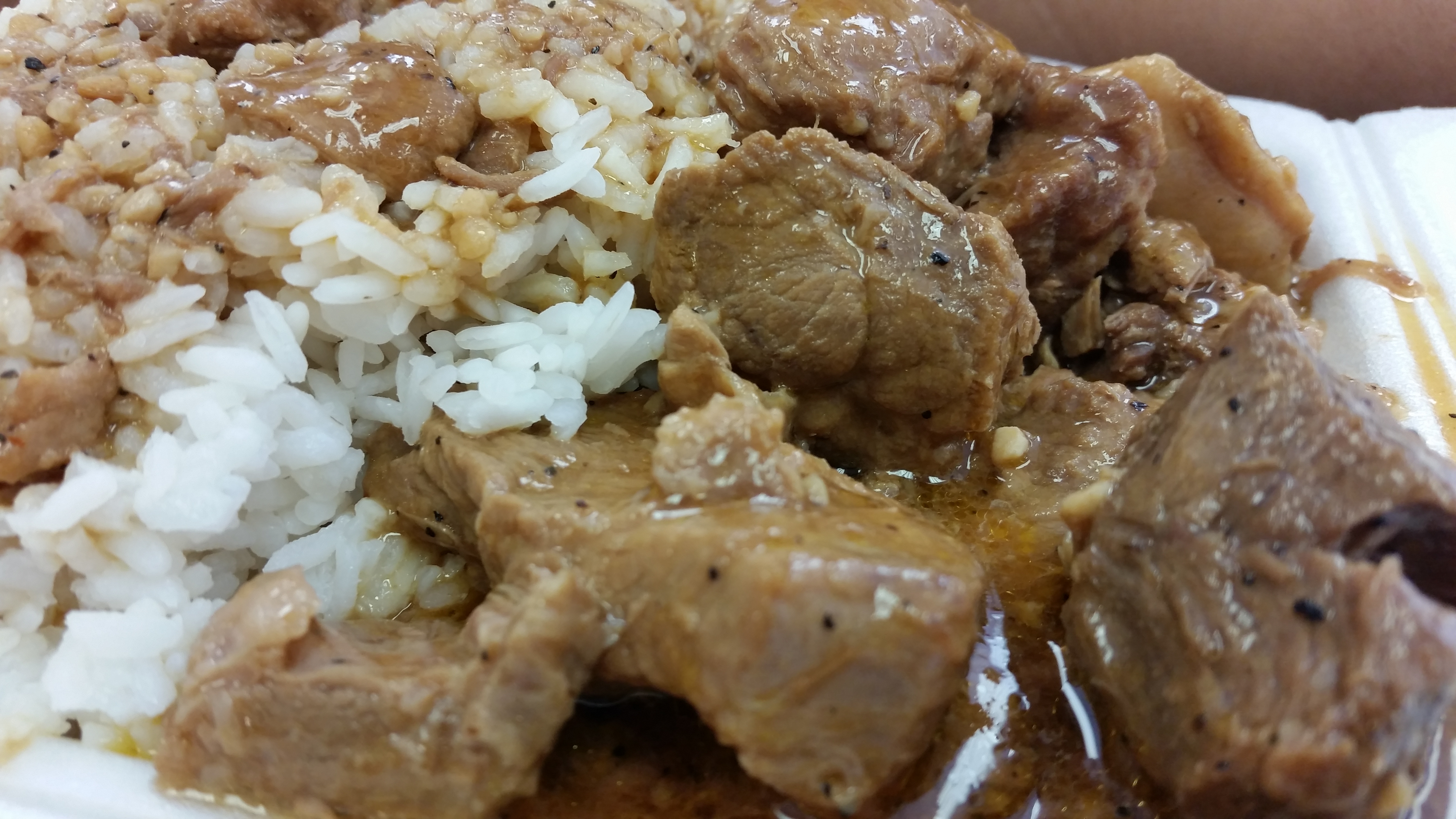 ''Paksiw'' refers to different vinegar-based stews that differ greatly from one another based on the type of meat used. ''Paksiw na isda'' uses fish and usually includes the addition of ginger, fish sauce, and maybe ''siling mahaba'' and vegetables. ''Paksiw na baboy'' is a ''paksiw'' using pork, usually pork hocks, and often sees the addition of sugar, banana blossoms, and water so that the meat is stewed in a sweet sauce. A similar Visayan dish called ''humba'' adds fermented black beans. Both dishes are probably related to ''pata tim'' which is of Chinese origin. ''Paksiw na lechon'' is made from ''lechon'' meat and features the addition of ground liver or liver spread. This adds flavor and thickens the sauce so that it starts to caramelize around the meat by the time dish is finished cooking. Although some versions of ''paksiw'' dishes are made using the same basic ingredients as ''adobo'', they are prepared differently, with other ingredients added and the proportions of ingredients and water being different.
In ''crispy pata'', pork knuckles (known as ''pata'') are marinated in garlic-flavored vinegar then deep fried until crisp and golden brown, with other parts of the pork leg prepared in the same way. ''Lechon manok'' is the Filipino take on rotisserie chicken. Available in many hole-in-the-wall stands or restaurant chains (e.g. Andok's, Baliwag, Toto's, Sr. Pedro's, G.S. Pagtakhan's), it is typically a specially seasoned chicken roasted over a charcoal flame served with "''sarsa''" or ''lechon'' sauce made from mashed pork liver, starch, sugar, and spices.
''Paksiw'' refers to different vinegar-based stews that differ greatly from one another based on the type of meat used. ''Paksiw na isda'' uses fish and usually includes the addition of ginger, fish sauce, and maybe ''siling mahaba'' and vegetables. ''Paksiw na baboy'' is a ''paksiw'' using pork, usually pork hocks, and often sees the addition of sugar, banana blossoms, and water so that the meat is stewed in a sweet sauce. A similar Visayan dish called ''humba'' adds fermented black beans. Both dishes are probably related to ''pata tim'' which is of Chinese origin. ''Paksiw na lechon'' is made from ''lechon'' meat and features the addition of ground liver or liver spread. This adds flavor and thickens the sauce so that it starts to caramelize around the meat by the time dish is finished cooking. Although some versions of ''paksiw'' dishes are made using the same basic ingredients as ''adobo'', they are prepared differently, with other ingredients added and the proportions of ingredients and water being different.
In ''crispy pata'', pork knuckles (known as ''pata'') are marinated in garlic-flavored vinegar then deep fried until crisp and golden brown, with other parts of the pork leg prepared in the same way. ''Lechon manok'' is the Filipino take on rotisserie chicken. Available in many hole-in-the-wall stands or restaurant chains (e.g. Andok's, Baliwag, Toto's, Sr. Pedro's, G.S. Pagtakhan's), it is typically a specially seasoned chicken roasted over a charcoal flame served with "''sarsa''" or ''lechon'' sauce made from mashed pork liver, starch, sugar, and spices.




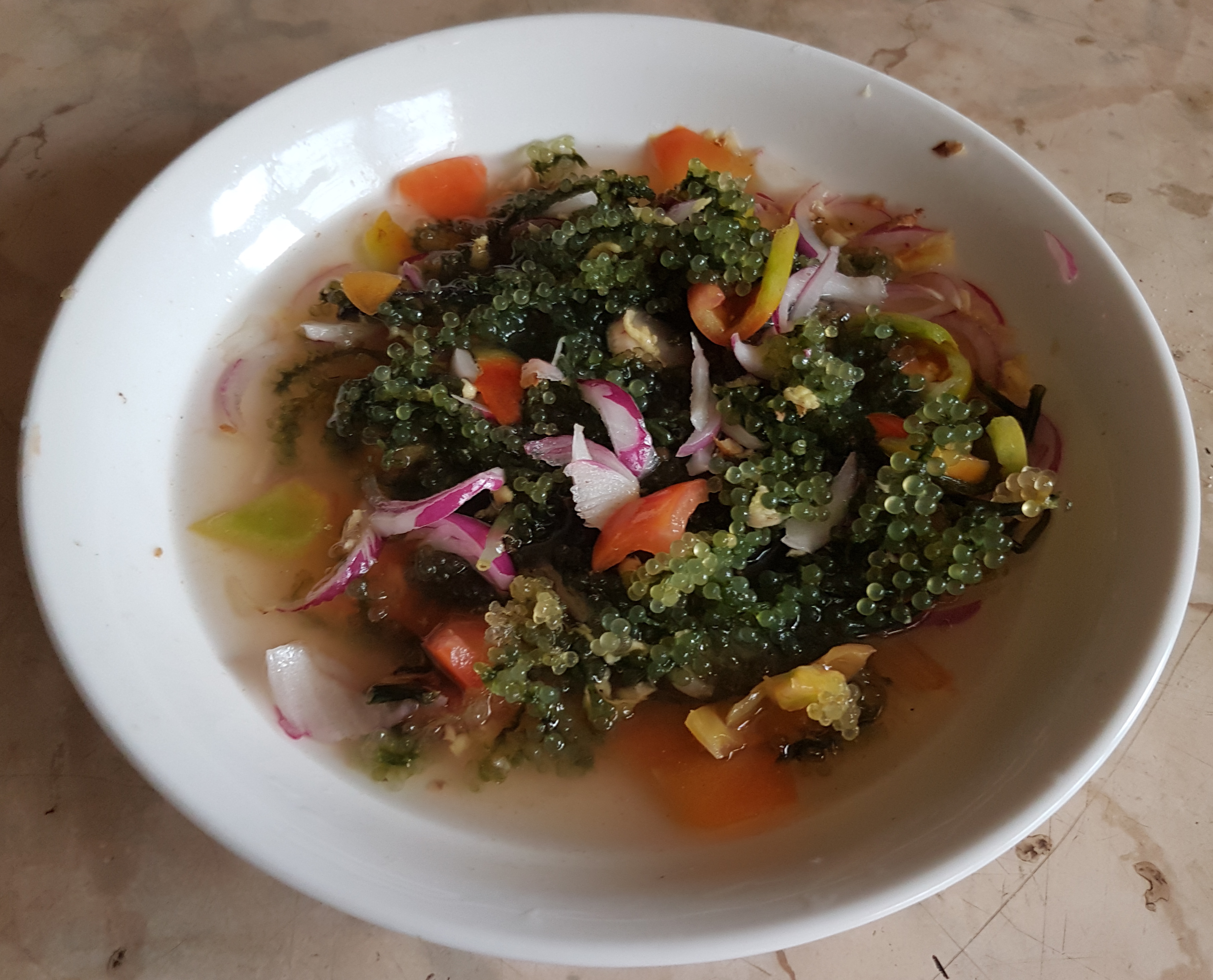 ''Mechado'', '' kaldereta'', and ''afritada'' are Spanish influenced tomato sauce-based dishes that are somewhat similar to one another. In these dishes meat is cooked in tomato sauce, minced garlic, and onions. ''Mechado'' gets its name from the pork fat that is inserted in a slab of beef making it look like a wick (''mitsa'') coming out of a beef "candle". The larded meat is then cooked in a seasoned tomato sauce and later sliced and served with the sauce it was cooked in. ''Kaldereta'' can be beef but is also associated with goat. Chunks of meat are cooked in tomato sauce, minced garlic, chopped onions, peas, carrots, bell peppers and potatoes to make a stew with some recipes calling for the addition of soy sauce, fish sauce, vinegar, chilies, ground liver or some combination thereof. ''Afritada'' tends to be the name given to the dish when chicken and pork is used. Another similar dish said to originate from the Rizal area is ''waknatoy''. Pork or beef sirloin is combined with potatoes and cut sausages and cooked in a tomato-based sauce sweetened with pickles. ''Puchero'' is derived from the Spanish ''cozido, cocido''; it is a sweeter stew that has beef and banana or plantain slices simmered in tomato sauce.
Filipinos also eat ''tocino'' and ''longganisa''. ''Tocino'' is a sweetened cured meat made with either chicken or pork and is marinated and cured for a number of days before being fried. ''Longanisa#Philippines, Longganisa'' is a sweet or spicy sausage, typically made from pork though other meats can also be used, and are often colored red traditionally through the use of the annatto seed but also artificial food coloring.
Filipino soups tend to be very hearty and stew-like containing large chunks of meat and vegetables or noodles. They are usually intended to be filling and not meant to be a light preparatory introduction for the main course. They tend to be served with the rest of the meal and eaten with rice when they are not meals unto themselves. They are often referred to on local menus under the heading ''sabaw'' (broth). ''Sinigang'' is a popular dish in this category distinguished by its sourness that often vies with ''adobo'' for consideration as the national dish. It is typically made with either pork, beef, chicken or seafood and made sour with tamarind or other suitable souring ingredients. Some seafood variants for example can be made sour by the use of guava fruit or miso. Another dish is ''tinola''. It has large chicken pieces and green papaya/Chayote, sayote slices cooked with chili, spinach, and Moringa oleifera, moringa leaves in a ginger-flavored broth. ''Nilagang baka'' is a beef stew made with cabbages and other vegetables. ''Binacol'' is a warm chicken soup cooked with coconut water and served with strips of coconut meat. ''La Paz batchoy'' is a noodle soup garnished with pork innards, crushed pork Pork rind, cracklings, chopped vegetables, and topped with a raw egg. Another dish with the same name uses misua, beef heart, kidneys and intestines, but does not contain eggs or vegetables. ''Mami Soup, Mami'' is a noodle soup made from chicken, beef, pork, wonton dumplings, or intestines (called ''laman-loob''). Ma Mon Luk was known for it. Another chicken noodle soup is ''sotanghon'', consisting of cellophane noodles (also called ''sotanghon'' and from whence the name of the dish is derived), chicken, and sometimes mushrooms.
''Mechado'', '' kaldereta'', and ''afritada'' are Spanish influenced tomato sauce-based dishes that are somewhat similar to one another. In these dishes meat is cooked in tomato sauce, minced garlic, and onions. ''Mechado'' gets its name from the pork fat that is inserted in a slab of beef making it look like a wick (''mitsa'') coming out of a beef "candle". The larded meat is then cooked in a seasoned tomato sauce and later sliced and served with the sauce it was cooked in. ''Kaldereta'' can be beef but is also associated with goat. Chunks of meat are cooked in tomato sauce, minced garlic, chopped onions, peas, carrots, bell peppers and potatoes to make a stew with some recipes calling for the addition of soy sauce, fish sauce, vinegar, chilies, ground liver or some combination thereof. ''Afritada'' tends to be the name given to the dish when chicken and pork is used. Another similar dish said to originate from the Rizal area is ''waknatoy''. Pork or beef sirloin is combined with potatoes and cut sausages and cooked in a tomato-based sauce sweetened with pickles. ''Puchero'' is derived from the Spanish ''cozido, cocido''; it is a sweeter stew that has beef and banana or plantain slices simmered in tomato sauce.
Filipinos also eat ''tocino'' and ''longganisa''. ''Tocino'' is a sweetened cured meat made with either chicken or pork and is marinated and cured for a number of days before being fried. ''Longanisa#Philippines, Longganisa'' is a sweet or spicy sausage, typically made from pork though other meats can also be used, and are often colored red traditionally through the use of the annatto seed but also artificial food coloring.
Filipino soups tend to be very hearty and stew-like containing large chunks of meat and vegetables or noodles. They are usually intended to be filling and not meant to be a light preparatory introduction for the main course. They tend to be served with the rest of the meal and eaten with rice when they are not meals unto themselves. They are often referred to on local menus under the heading ''sabaw'' (broth). ''Sinigang'' is a popular dish in this category distinguished by its sourness that often vies with ''adobo'' for consideration as the national dish. It is typically made with either pork, beef, chicken or seafood and made sour with tamarind or other suitable souring ingredients. Some seafood variants for example can be made sour by the use of guava fruit or miso. Another dish is ''tinola''. It has large chicken pieces and green papaya/Chayote, sayote slices cooked with chili, spinach, and Moringa oleifera, moringa leaves in a ginger-flavored broth. ''Nilagang baka'' is a beef stew made with cabbages and other vegetables. ''Binacol'' is a warm chicken soup cooked with coconut water and served with strips of coconut meat. ''La Paz batchoy'' is a noodle soup garnished with pork innards, crushed pork Pork rind, cracklings, chopped vegetables, and topped with a raw egg. Another dish with the same name uses misua, beef heart, kidneys and intestines, but does not contain eggs or vegetables. ''Mami Soup, Mami'' is a noodle soup made from chicken, beef, pork, wonton dumplings, or intestines (called ''laman-loob''). Ma Mon Luk was known for it. Another chicken noodle soup is ''sotanghon'', consisting of cellophane noodles (also called ''sotanghon'' and from whence the name of the dish is derived), chicken, and sometimes mushrooms.
=Cooking methods of most common dishes
= The Filipino words commonly used for cooking methods and terms are listed below:
* Adobo (Filipino cuisine), Adobo (''inadobo'') − cooked in vinegar, oil, garlic and soy sauce.
* Afritada – braised in tomato sauce.
* Babad (''binabad'', ''ibinabad'') − to marinate.
* Banli (''binanlian, ''pabanli'') − to blanch.
* Bagoong (''binagoongan'', ''sa bagoong'') − fermented or cooked with fermented fish/shrimp paste (''bagoong'')
* Bibingka – baked cakes, traditionally glutinous rice.
* Binalot – literally "wrapped." This generally refers to dishes wrapped in banana leaves, pandan leaves, or even aluminum foil. The wrapper is generally inedible (in contrast to ''lumpia''—see below).
* Buro (''binuro'') − fermented, pickled, or preserved in salt or vinegar. Synonymous with ''tapai, tapay'' in other Philippine languages when referring to fermented rice.
* Daing (, ) − salted and dried, usually fish or seafood. Synonymous with ''tuyô'', ''bulad'' or ''buwad'' in other Philippine languages
* Giniling – ground meat. Sometimes used as a synonym for picadillo, especially in ''arroz a la cubana''.
* Guinataan (''sa gata'') − cooked with coconut milk.
* Guisa (''guisado'', ''ginuisa'') − sautéed with garlic, onions or tomatoes. Also spelled ''gisa'', ''gisado'', ''ginisa''.
* Hamonado (''endulsado'') – marinated or cooked in a sweet pineapple sauce. Sometimes synonymous with ''pininyahan'' or ''minatamis''
* Halabos (''hinalabos'') – mostly for shellfish. Steamed in their own juices and sometimes carbonated soda.
* Halo-Halo - made up of crushed ice, evaporated milk or condensed milk, and various ingredients including, ube, sweetened beans, coconut strips, sago, gulaman (agar), pinipig rice, boiled taro or soft yams in cubes, fruit slices, flan, and topped with a scoop of ube ice cream.
* Hilaw (''sariwa'') – unripe (for fruits and vegetables), raw (for meats). Also used for uncooked food in general (as in '' lumpiang sariwa'').
* Hinurno – baked in an oven (''pugon'') or roasted.
* Ihaw (''inihaw'') − grilled over coal. In Visayas, it is also known as ''sinugba''; ''inasal'' refers to grilling meat on sticks.
* Kinilaw or Kilawin − fish or seafood marinated in vinegar or calamansi juice along with garlic, onions, ginger, tomato, Capsicum, peppers. Also means to eat raw or fresh, cognate of ''Hilaw''.
* Lechon (''nilechon'') − roasted on a spit. Also spelled ''litson''.
* Lumpia – savory food wrapped with an edible wrapper.
* Minatamis (''minatamisan'') − sweetened. Similar to ''hamonado''.
* Nilaga (''laga'', ''palaga'') − boiled/braised.
* Nilasing − cooked with an alcoholic beverage like wine or beer.
* Paksiw (''pinaksiw'') − cooked in vinegar.
* Pancit (''pansit'', ''fideo'') – noodle dishes, usually of Filipino Chinese cuisine, Chinese Filipino origin.
* Pangat (''pinangat'') − boiled in salted water/brine with fruit such as tomatoes or ripe mangoes.
* Palaman (''pinalaman'', ''pinalamanan'') − "filled" as in ''siopao'', though "palaman" also refers to the filling in a sandwich.
* Pinakbet (''pakbet'') − to cook with vegetables usually with ''sitaw'' (yardlong beans), calabaza, ''talong'' (eggplant), and ''ampalaya'' (bitter melon) among others and ''bagoong''.
* Pinakuluan – boiled.
* Pininyahan – marinated or cooked with pineapples. Sometimes synonymous with ''hamonado''.
* Prito (''pinirito'') − fried or deep fried. From the Spanish ''frito''.
* Puto (food), Puto – steamed cakes, traditionally glutinous rice.
* Relleno (''relyeno'') – stuffed.
* Sarza (''sarciado'') – cooked with a thick sauce.
* Sinangag – garlic fried rice.
* Sisig - is a traditional food of Filipino specially partnered with beer. It made by different parts of pig.
* Sinigang, Sigang (''sinigang'') − boiled in a sour broth usually with a tamarind base. Other common souring agents include guava, raw mangoes, calamansi also known as calamondin.
* Tapa (Filipino cuisine), Tapa or Tinapa – dried and smoked. ''Tapa'' refers to meat treated in this manner, mostly marinated and then dried and fried afterwards. ''Tinapa'' meanwhile is almost exclusively associated with smoked fish.
* Tapai, Tapay – fermented with yeast, usually rice, traditionally in tapayan jars. Synonymous with ''buro'' in early phases. Can also refer to various products of fermented rice, including rice wines. A very briefly fermented glutinous rice version is known as ''galapong'', which is an essential ingredient in Filipino ''kakanin'' (rice cakes). Cognate of ''tinapay'' (leavened bread).
* Tosta (''tinosta'', ''tostado'') – toasted.
* Torta (''tinorta'', ''patorta'') – in the northern Philippines, to cook with eggs in the manner of an omelette. In the southern Philippines, a general term for a torta mamon, small cake.
* Turon (''turrones'') – wrapped with an edible wrapper; dessert counterpart of lumpia.
The Filipino words commonly used for cooking methods and terms are listed below:
* Adobo (Filipino cuisine), Adobo (''inadobo'') − cooked in vinegar, oil, garlic and soy sauce.
* Afritada – braised in tomato sauce.
* Babad (''binabad'', ''ibinabad'') − to marinate.
* Banli (''binanlian, ''pabanli'') − to blanch.
* Bagoong (''binagoongan'', ''sa bagoong'') − fermented or cooked with fermented fish/shrimp paste (''bagoong'')
* Bibingka – baked cakes, traditionally glutinous rice.
* Binalot – literally "wrapped." This generally refers to dishes wrapped in banana leaves, pandan leaves, or even aluminum foil. The wrapper is generally inedible (in contrast to ''lumpia''—see below).
* Buro (''binuro'') − fermented, pickled, or preserved in salt or vinegar. Synonymous with ''tapai, tapay'' in other Philippine languages when referring to fermented rice.
* Daing (, ) − salted and dried, usually fish or seafood. Synonymous with ''tuyô'', ''bulad'' or ''buwad'' in other Philippine languages
* Giniling – ground meat. Sometimes used as a synonym for picadillo, especially in ''arroz a la cubana''.
* Guinataan (''sa gata'') − cooked with coconut milk.
* Guisa (''guisado'', ''ginuisa'') − sautéed with garlic, onions or tomatoes. Also spelled ''gisa'', ''gisado'', ''ginisa''.
* Hamonado (''endulsado'') – marinated or cooked in a sweet pineapple sauce. Sometimes synonymous with ''pininyahan'' or ''minatamis''
* Halabos (''hinalabos'') – mostly for shellfish. Steamed in their own juices and sometimes carbonated soda.
* Halo-Halo - made up of crushed ice, evaporated milk or condensed milk, and various ingredients including, ube, sweetened beans, coconut strips, sago, gulaman (agar), pinipig rice, boiled taro or soft yams in cubes, fruit slices, flan, and topped with a scoop of ube ice cream.
* Hilaw (''sariwa'') – unripe (for fruits and vegetables), raw (for meats). Also used for uncooked food in general (as in '' lumpiang sariwa'').
* Hinurno – baked in an oven (''pugon'') or roasted.
* Ihaw (''inihaw'') − grilled over coal. In Visayas, it is also known as ''sinugba''; ''inasal'' refers to grilling meat on sticks.
* Kinilaw or Kilawin − fish or seafood marinated in vinegar or calamansi juice along with garlic, onions, ginger, tomato, Capsicum, peppers. Also means to eat raw or fresh, cognate of ''Hilaw''.
* Lechon (''nilechon'') − roasted on a spit. Also spelled ''litson''.
* Lumpia – savory food wrapped with an edible wrapper.
* Minatamis (''minatamisan'') − sweetened. Similar to ''hamonado''.
* Nilaga (''laga'', ''palaga'') − boiled/braised.
* Nilasing − cooked with an alcoholic beverage like wine or beer.
* Paksiw (''pinaksiw'') − cooked in vinegar.
* Pancit (''pansit'', ''fideo'') – noodle dishes, usually of Filipino Chinese cuisine, Chinese Filipino origin.
* Pangat (''pinangat'') − boiled in salted water/brine with fruit such as tomatoes or ripe mangoes.
* Palaman (''pinalaman'', ''pinalamanan'') − "filled" as in ''siopao'', though "palaman" also refers to the filling in a sandwich.
* Pinakbet (''pakbet'') − to cook with vegetables usually with ''sitaw'' (yardlong beans), calabaza, ''talong'' (eggplant), and ''ampalaya'' (bitter melon) among others and ''bagoong''.
* Pinakuluan – boiled.
* Pininyahan – marinated or cooked with pineapples. Sometimes synonymous with ''hamonado''.
* Prito (''pinirito'') − fried or deep fried. From the Spanish ''frito''.
* Puto (food), Puto – steamed cakes, traditionally glutinous rice.
* Relleno (''relyeno'') – stuffed.
* Sarza (''sarciado'') – cooked with a thick sauce.
* Sinangag – garlic fried rice.
* Sisig - is a traditional food of Filipino specially partnered with beer. It made by different parts of pig.
* Sinigang, Sigang (''sinigang'') − boiled in a sour broth usually with a tamarind base. Other common souring agents include guava, raw mangoes, calamansi also known as calamondin.
* Tapa (Filipino cuisine), Tapa or Tinapa – dried and smoked. ''Tapa'' refers to meat treated in this manner, mostly marinated and then dried and fried afterwards. ''Tinapa'' meanwhile is almost exclusively associated with smoked fish.
* Tapai, Tapay – fermented with yeast, usually rice, traditionally in tapayan jars. Synonymous with ''buro'' in early phases. Can also refer to various products of fermented rice, including rice wines. A very briefly fermented glutinous rice version is known as ''galapong'', which is an essential ingredient in Filipino ''kakanin'' (rice cakes). Cognate of ''tinapay'' (leavened bread).
* Tosta (''tinosta'', ''tostado'') – toasted.
* Torta (''tinorta'', ''patorta'') – in the northern Philippines, to cook with eggs in the manner of an omelette. In the southern Philippines, a general term for a torta mamon, small cake.
* Turon (''turrones'') – wrapped with an edible wrapper; dessert counterpart of lumpia.
=Bread and pastries
= In a typical Filipino bakery, ''pandesal'', ''Monay (bread), monay'' and ''ensaymada'' are often sold. ''Pandesal'' comes from the Spanish ''pan de sal'' (literally, bread of salt), and is a ubiquitous breakfast fare, normally eaten with (and sometimes even dipped in) coffee. It typically takes the form of a bread roll, and is usually baked covered in bread crumbs. Contrary to what its name implies, ''pandesal'' is not particularly salty as very little salt is used in baking it. ''Monay'' is a firmer slightly denser heavier bread. ''Ensaymada'', from the Spanish ''ensaimada'', is a pastry made using butter and often topped with sugar and shredded cheese that is especially popular during Christmas. It is sometimes made with fillings such as ''
In a typical Filipino bakery, ''pandesal'', ''Monay (bread), monay'' and ''ensaymada'' are often sold. ''Pandesal'' comes from the Spanish ''pan de sal'' (literally, bread of salt), and is a ubiquitous breakfast fare, normally eaten with (and sometimes even dipped in) coffee. It typically takes the form of a bread roll, and is usually baked covered in bread crumbs. Contrary to what its name implies, ''pandesal'' is not particularly salty as very little salt is used in baking it. ''Monay'' is a firmer slightly denser heavier bread. ''Ensaymada'', from the Spanish ''ensaimada'', is a pastry made using butter and often topped with sugar and shredded cheese that is especially popular during Christmas. It is sometimes made with fillings such as ''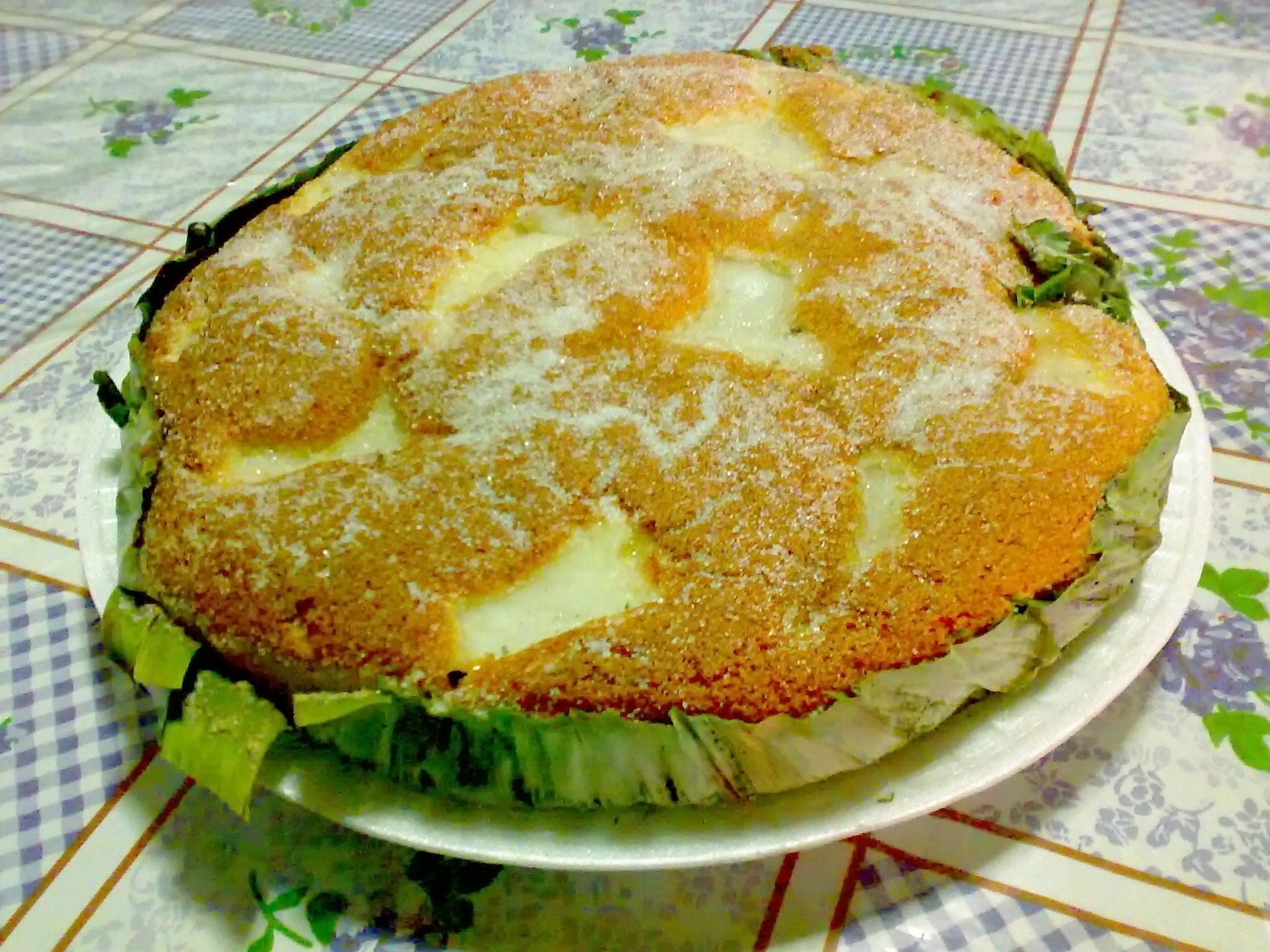 There are also rolls like ''Pionono, pianono'', which is a chiffon roll flavored with different fillings. ''Brazo de Mercedes, Brazo de mercedes'', a rolled cake or jelly roll, is made from a sheet of meringue rolled around a custard filling. Similar to the previous dessert, it takes on a layered presentation instead of being rolled and typically features caramelized sugar and nuts for ''sans rival''. ''Silvana (food), Silvañas'' are large, oval-shaped, cookie-sized desserts, with a thin meringue on either side of a buttercream filling and dusted with crumbed cookies. Not overly sweet, they are rich, crisp, chewy, and buttery all at the same time. ''Barquillos'' use sweet thin crunchy wafers rolled into tubes that can be sold hollow or filled with ''Polvorón, polvoron'' (sweetened and toasted flour mixed with ground nuts). Meringues are also present in the Philippines, due to the Spanish influence, but they are called ''merengue'' – with all the vowels pronounced. ''Leche Flan, Leche flan'' is a type of caramel custard made with eggs and milk similar to the French creme caramel. ''Leche flan'' (the local term for the original Spanish ''flan de leche'', literally "milk flan") is a heavier version of the Spanish flan made with condensed milk and more egg yolks. ''Leche flan'' is usually steamed over an open flame or stove top, although on rare occasions it can also be seen baked. ''Leche flan'' is a staple in celebratory feasts.
A heavier version of ''leche flan'', ''Crème caramel, tocino del cielo'', is similar, but has significantly more egg yolks and sugar.
There are also rolls like ''Pionono, pianono'', which is a chiffon roll flavored with different fillings. ''Brazo de Mercedes, Brazo de mercedes'', a rolled cake or jelly roll, is made from a sheet of meringue rolled around a custard filling. Similar to the previous dessert, it takes on a layered presentation instead of being rolled and typically features caramelized sugar and nuts for ''sans rival''. ''Silvana (food), Silvañas'' are large, oval-shaped, cookie-sized desserts, with a thin meringue on either side of a buttercream filling and dusted with crumbed cookies. Not overly sweet, they are rich, crisp, chewy, and buttery all at the same time. ''Barquillos'' use sweet thin crunchy wafers rolled into tubes that can be sold hollow or filled with ''Polvorón, polvoron'' (sweetened and toasted flour mixed with ground nuts). Meringues are also present in the Philippines, due to the Spanish influence, but they are called ''merengue'' – with all the vowels pronounced. ''Leche Flan, Leche flan'' is a type of caramel custard made with eggs and milk similar to the French creme caramel. ''Leche flan'' (the local term for the original Spanish ''flan de leche'', literally "milk flan") is a heavier version of the Spanish flan made with condensed milk and more egg yolks. ''Leche flan'' is usually steamed over an open flame or stove top, although on rare occasions it can also be seen baked. ''Leche flan'' is a staple in celebratory feasts.
A heavier version of ''leche flan'', ''Crème caramel, tocino del cielo'', is similar, but has significantly more egg yolks and sugar.
 The ''egg pie'' with a very rich egg custard filling is a mainstay in local bakeries. It is typically baked so that the exposed custard on top is browned. Buko pie, ''Buko'' pie is made with a filling made from young coconut meat and dairy. Mini pastries like ''Turrones de casúy, turrones de casuy'' are made up of cashew marzipan wrapped with a wafer made to resemble a candy wrapper but take on a miniature look of a pie in a size of about a Quarter (United States coin), quarter. There is also ''napoleones'' – again with all the vowels pronounced – a mille-feuille pastry stuffed with a sweet milk-based filling.
There are hard pastries like ''biskotso'' a crunchy, sweet, twice-baked bread. Another baked goody is ''sinipit'' which is a sweet pastry covered in a crunchy sugar glaze, made to resemble a length of rope. Similar to ''sinipit'' is a snack eaten on roadsides colloquially called ''shingaling''. It is hollow but crunchy with a salty flavor.
The ''egg pie'' with a very rich egg custard filling is a mainstay in local bakeries. It is typically baked so that the exposed custard on top is browned. Buko pie, ''Buko'' pie is made with a filling made from young coconut meat and dairy. Mini pastries like ''Turrones de casúy, turrones de casuy'' are made up of cashew marzipan wrapped with a wafer made to resemble a candy wrapper but take on a miniature look of a pie in a size of about a Quarter (United States coin), quarter. There is also ''napoleones'' – again with all the vowels pronounced – a mille-feuille pastry stuffed with a sweet milk-based filling.
There are hard pastries like ''biskotso'' a crunchy, sweet, twice-baked bread. Another baked goody is ''sinipit'' which is a sweet pastry covered in a crunchy sugar glaze, made to resemble a length of rope. Similar to ''sinipit'' is a snack eaten on roadsides colloquially called ''shingaling''. It is hollow but crunchy with a salty flavor.
 For a softer treat there is ''Mamón, mamon'' a chiffon-type cake sprinkled with sugar, its name derived from a slang Spanish term for breast. There's also ''crema de fruta'', which is an elaborate sponge cake topped in succeeding layers of cream, custard, candied fruit, and gelatin. Similar to a sponge cake is ''mamoncillo'' which generally refers to slices taken from a large ''mamon cake'', but it is unrelated to the Mamoncillo, fruit of the same name. Sandwich pastries like ''inipit'' are made with two thin layers of chiffon sandwiching a filling of custard that is topped with butter and sugar. Another ''mamon'' variant is ''mamon tostada'', basically ''mamoncillo'' toasted to a crunchy texture.
Stuffed pastries that reflect both Western and Eastern influence are common. One can find empanadas, a turnover-type pastry filled with a savory-sweet meat filling. Typically filled with ground meat and raisins, it can be deep fried or baked. ''Siopao'' is the local version of Chinese baozi. ''Buchi'' is another snack that is likely of Chinese origin. Bite-sized, ''buchi'' is made of deep-fried dough balls (often from rice flour) filled with a sweet mung bean paste, and coated on the outside with sesame seeds; some variants also have ''
For a softer treat there is ''Mamón, mamon'' a chiffon-type cake sprinkled with sugar, its name derived from a slang Spanish term for breast. There's also ''crema de fruta'', which is an elaborate sponge cake topped in succeeding layers of cream, custard, candied fruit, and gelatin. Similar to a sponge cake is ''mamoncillo'' which generally refers to slices taken from a large ''mamon cake'', but it is unrelated to the Mamoncillo, fruit of the same name. Sandwich pastries like ''inipit'' are made with two thin layers of chiffon sandwiching a filling of custard that is topped with butter and sugar. Another ''mamon'' variant is ''mamon tostada'', basically ''mamoncillo'' toasted to a crunchy texture.
Stuffed pastries that reflect both Western and Eastern influence are common. One can find empanadas, a turnover-type pastry filled with a savory-sweet meat filling. Typically filled with ground meat and raisins, it can be deep fried or baked. ''Siopao'' is the local version of Chinese baozi. ''Buchi'' is another snack that is likely of Chinese origin. Bite-sized, ''buchi'' is made of deep-fried dough balls (often from rice flour) filled with a sweet mung bean paste, and coated on the outside with sesame seeds; some variants also have ''Side dishes
 ''Itlog na pula'' (red eggs) are duck eggs that have been cured in brine or a mixture of clay-and-salt for a few weeks, making them salty. They are later hard boiled and dyed with red food coloring (hence the name) to distinguish them from chicken eggs before they are sold over the shelves. They are often served mixed in with diced tomatoes. '' Atchara'' is a side dish of pickled papaya strips similar to sauerkraut. It's a frequent accompaniment to fried dishes like ''tapa'' or ''daing''.
''Nata de coco'' is a chewy, translucent, jelly-like food product produced by the fermentation of coconut water can be served with ''pandesal''. ''Kesong puti'' is a soft white cheese made from carabao milk (although cow milk is also used in most commercial variants). Grated mature coconut (''niyog''), is normally served with sweet rice-based desserts.
''Itlog na pula'' (red eggs) are duck eggs that have been cured in brine or a mixture of clay-and-salt for a few weeks, making them salty. They are later hard boiled and dyed with red food coloring (hence the name) to distinguish them from chicken eggs before they are sold over the shelves. They are often served mixed in with diced tomatoes. '' Atchara'' is a side dish of pickled papaya strips similar to sauerkraut. It's a frequent accompaniment to fried dishes like ''tapa'' or ''daing''.
''Nata de coco'' is a chewy, translucent, jelly-like food product produced by the fermentation of coconut water can be served with ''pandesal''. ''Kesong puti'' is a soft white cheese made from carabao milk (although cow milk is also used in most commercial variants). Grated mature coconut (''niyog''), is normally served with sweet rice-based desserts.
Beverages
=Chilled drinks and shakes
=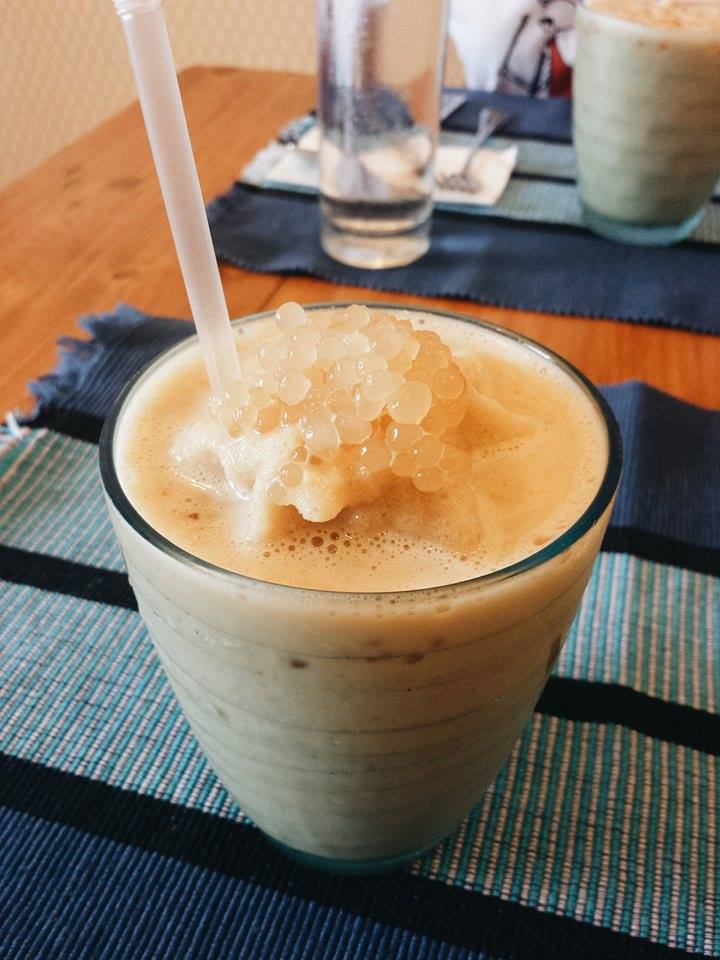
 Chilled drinks are popular due to the tropical climate. Stands selling cold fruit drinks and fruit shakes are common in many of the city areas, where some are based on Mandarin orange, green mandarin orange (''dalandan'' or ''dalanghita''), pomelo (''suha''), pineapple (''pinya''), banana (''saging''), and soursop (''guyabano''). The shakes usually contain crushed ice, evaporated or condensed milk, and fruits like mango, avocado, cantaloupe, durian, papaya, strawberry and watermelon, to name a few.
Other chilled drinks include ''sago't gulaman,'' a flavored ice drink of pre-Hispanic Malay race, Malay origin (Malay: ''gula melaka'') with sago and agar gelatin with banana extract sometimes added to the accompanying syrup; fresh ''buko'' or coconut juice, the water or juice straight out of a young coconut via an inserted straw, a less fresh variation of which is from bottled coconut juice, scraped coconut flesh, sugar, and water; and kalamansi juice, the juice of kalamansi or Philippine limes usually sweetened with honey, syrup or sugar.
Chilled drinks are popular due to the tropical climate. Stands selling cold fruit drinks and fruit shakes are common in many of the city areas, where some are based on Mandarin orange, green mandarin orange (''dalandan'' or ''dalanghita''), pomelo (''suha''), pineapple (''pinya''), banana (''saging''), and soursop (''guyabano''). The shakes usually contain crushed ice, evaporated or condensed milk, and fruits like mango, avocado, cantaloupe, durian, papaya, strawberry and watermelon, to name a few.
Other chilled drinks include ''sago't gulaman,'' a flavored ice drink of pre-Hispanic Malay race, Malay origin (Malay: ''gula melaka'') with sago and agar gelatin with banana extract sometimes added to the accompanying syrup; fresh ''buko'' or coconut juice, the water or juice straight out of a young coconut via an inserted straw, a less fresh variation of which is from bottled coconut juice, scraped coconut flesh, sugar, and water; and kalamansi juice, the juice of kalamansi or Philippine limes usually sweetened with honey, syrup or sugar.
=Brewed beverages
= The Philippines is a predominantly coffee-drinking nation. One of the most popular variants of coffee coming from the mountains of Batangas is known as ''Kape Barako, kapeng barako''. Another well-known variant of coffee is the ''kopi luwak, civet coffee''. It is called ''kape motit'' in the Cordilleras, ''kape alamid'' in Tagalog region, and ''kape musang'' in Mindanao. The Kalinga coffee known for its organic production is also rapidly gaining popularity. Highlands coffee, or Benguet coffee, is a blend of Robusta and Excelsa beans. Even before the establishment of coffeehouses in the Philippines, coffee has been part of the Filipino meal. Carinderias would often serve them along with meals. The opening of Starbucks in 1997 paved the way for other coffee shops. Tea consumption in the Philippines is driven primarily by growing health consciousness amongst middle- to high-income consumers. Tea is commonly prepared using Carmona retusa, Philippine wild tea or Thea sinensis, tea tree. There are several known variations of tea using different additives. Pandan iced tea is one of these, made with Pandanus, pandan leaves and lemongrass (locally known as ''tanglad''). Ginger tea, ''Salabat'', sometimes called ginger tea, is brewed from ginger root and usually served during the cold months, and when illnesses such as flu or sore throat strikes. The late 2010s saw the opening of teahouses in major cities, and with a glass of milk tea being more affordable than the usual cold designer coffee, it paved the way into making tea a well-known food trend. Notable teahouse chains in the Philippines are Chatime and Serenitea. ''Tsokolate'' is the Filipino style of hot chocolate. It is traditionally made with ''tablea'', which are pure cacao beans that are dried, roasted, ground and then formed into tablets. It is also popular during Christmas in the Philippines, Christmas season, particularly among children.=Alcoholic beverages
= There are a wide variety of alcoholic drinks in the Philippines manufactured by local breweries and distilleries. Red Horse Beer, Red Horse is one of the most popular beer.Traditional drinks

 ''Palm wine, Tuba'' (toddy) is a type of hard liquor made from fresh drippings extracted from a cut young stem of palm. The cutting of the palm stem usually done early in the morning by a ''mananguete'', a person who climbs palm trees and extracts the ''tuba'' to supply to customers later in the day. The morning's accumulated palm juice or drippings are then harvested by noon, and brought to buyers then prepared for consumption. Sometimes this is done twice a day so that there are two harvests of ''tuba'' occurring first at noon-time and then in the late-afternoon. Normally, ''tuba'' has to be consumed right after the ''mananguete'' brings it over, or it becomes too sour to be consumed as a drink. Any remaining unconsumed ''tuba'' is then often stored in jars to ferment for several days and become palm vinegar. ''Tuba'' can be distilled to produce ''lambanog'' (arrack), a neutral liquor often noted for its relatively high alcohol content.
Lambanog is an alcoholic beverage commonly described as coconut wine or coconut vodka. The drink is distilled from the sap of the unopened coconut flower, and is known for its potency and high alcohol content (80 and 90 proof). Most of the Lambanog distilleries are in the Quezon province of Luzon, Philippines. Constant efforts at standardizing lambanog production has led to its better quality. Presently, lambanog is being exported to other countries and continues to win foreign customers over due to its natural ingredients as well as its potency.
''Tapuy'' is a traditional Philippine alcoholic drink made from fermented ''glutinous rice''. It is a clear wine of luxurious alcoholic taste, moderate sweetness and lingering finish. Its average alcohol content is 14% or 28 proof, and it does not contain any preservatives or sugar. To increase the awareness of ''tapuy'', the Philippine Rice Research Institute has created a cookbook containing recipes and cocktails from famous Filipino chefs and bartenders, featuring ''tapuy'' as one of the ingredients.
''Palm wine, Tuba'' (toddy) is a type of hard liquor made from fresh drippings extracted from a cut young stem of palm. The cutting of the palm stem usually done early in the morning by a ''mananguete'', a person who climbs palm trees and extracts the ''tuba'' to supply to customers later in the day. The morning's accumulated palm juice or drippings are then harvested by noon, and brought to buyers then prepared for consumption. Sometimes this is done twice a day so that there are two harvests of ''tuba'' occurring first at noon-time and then in the late-afternoon. Normally, ''tuba'' has to be consumed right after the ''mananguete'' brings it over, or it becomes too sour to be consumed as a drink. Any remaining unconsumed ''tuba'' is then often stored in jars to ferment for several days and become palm vinegar. ''Tuba'' can be distilled to produce ''lambanog'' (arrack), a neutral liquor often noted for its relatively high alcohol content.
Lambanog is an alcoholic beverage commonly described as coconut wine or coconut vodka. The drink is distilled from the sap of the unopened coconut flower, and is known for its potency and high alcohol content (80 and 90 proof). Most of the Lambanog distilleries are in the Quezon province of Luzon, Philippines. Constant efforts at standardizing lambanog production has led to its better quality. Presently, lambanog is being exported to other countries and continues to win foreign customers over due to its natural ingredients as well as its potency.
''Tapuy'' is a traditional Philippine alcoholic drink made from fermented ''glutinous rice''. It is a clear wine of luxurious alcoholic taste, moderate sweetness and lingering finish. Its average alcohol content is 14% or 28 proof, and it does not contain any preservatives or sugar. To increase the awareness of ''tapuy'', the Philippine Rice Research Institute has created a cookbook containing recipes and cocktails from famous Filipino chefs and bartenders, featuring ''tapuy'' as one of the ingredients.
Modern drinks Beer or ''serbesa'' (from the Spanish "cerveza") is the most widely available alcoholic drink in the Philippines. San Miguel Beer, San Miguel Pale Pilsen is the most popular and widely sold brand. Together with associated San Miguel beer brands such as San Mig Light and Gold Eagle Beer the company holds an aggregate market share of 92.7%. Beer na Beer produced by local conglomerate Asia Brewery is another widely sold pale Pilsner style beer. Asia Brewery also produces under license and distributes a number of other mass market beers such as Colt 45, Asahi Super Dry, Heineken and Tiger Beer. Other beer labels include Red Horse Beer, Lone Star, Lone Star Light, Lone Star Ultra, Carlsberg, Coors Light, San Miguel Superdry, San Mig Strong Ice, and just recently, Manila Beer. Echoing trends in international markets, bars in urban areas have also begun to serve locally produced and imported craft beers in a variety of styles. Rum is often associated with Tanduay. Several gins, both local varieties like Ginebra San Miguel (as well as GSM Blue and GSM Premium Gin) and imported brands like Gilbey's, are commonly found. Some people refer to gin by the shape of the bottle: ''bilog'' for a circular bottle and ''kwatro kantos'' (literally meaning four corners) for a square or rectangular bottle. Gin is sometimes combined with other ingredients to come up with variations.
Desserts

 As the Philippines is a tropical country, many desserts made from rice and coconuts. One often seen dessert is ''
As the Philippines is a tropical country, many desserts made from rice and coconuts. One often seen dessert is ''Regional specialties
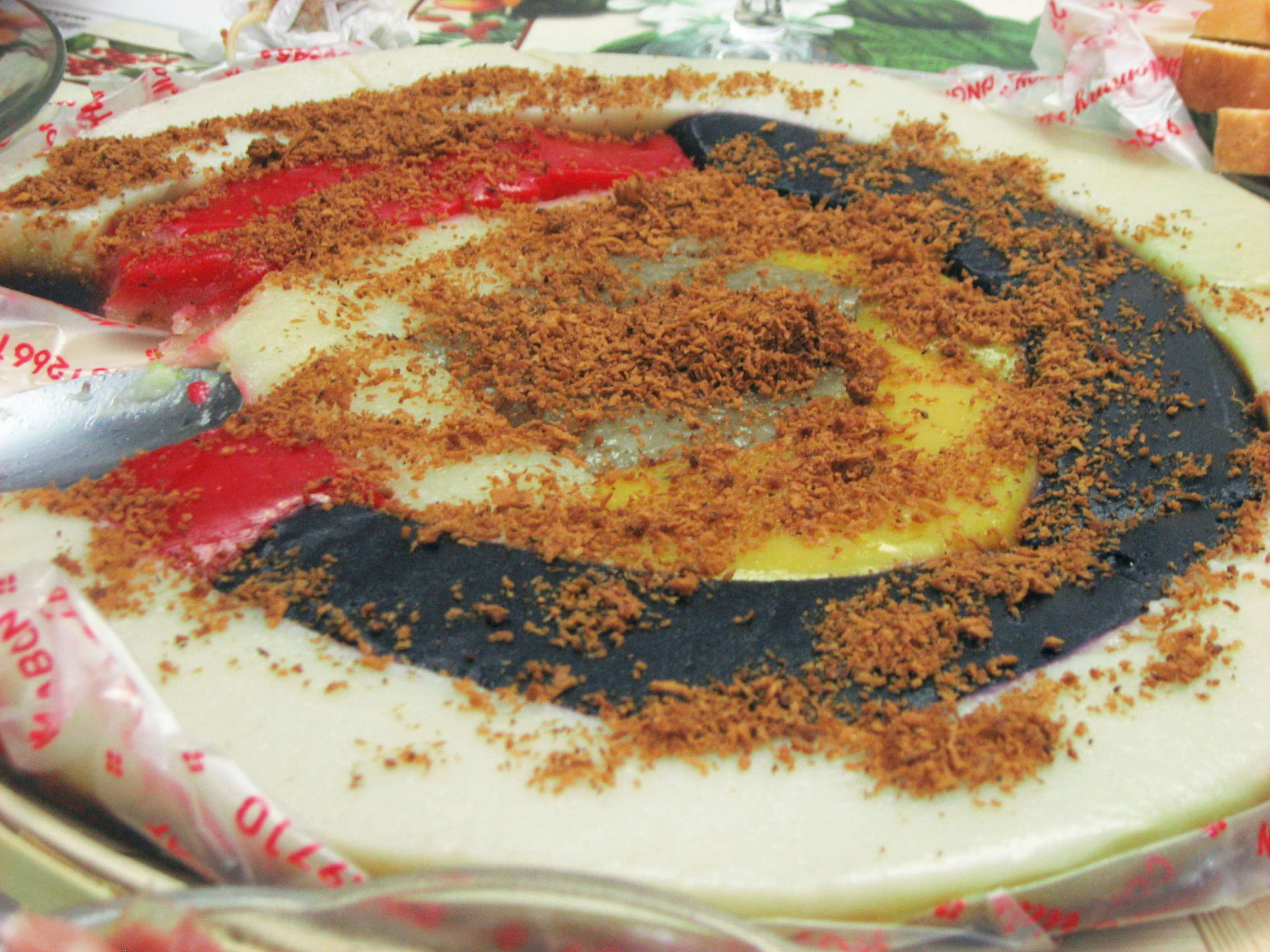
Luzon cuisine
Ilocano people, Ilocanos from the mountainous Ilocos Region commonly have diets heavy in boiled or steamed vegetables and freshwater fish, and they are particularly fond of dishes flavored with ''Bagoong terong, bagoong'', fermented fish that is often used as a substitute for salt. Ilocanos often season boiled vegetables with ''bagoong monamon'' (fermented anchovy paste) to produce '' Bicol Region, Bicol is noted for its gastronomic appetite for the fiery or chili-hot dishes. Perhaps the most well-known Bicolano dish is the very spicy Bicol Express. The region is also the well-known home of ''Natong (food), natong'' also known as ''laing'' or ''Laing (food), pinangat'' (pork or fish stew in taro leaves).
Bicol Region, Bicol is noted for its gastronomic appetite for the fiery or chili-hot dishes. Perhaps the most well-known Bicolano dish is the very spicy Bicol Express. The region is also the well-known home of ''Natong (food), natong'' also known as ''laing'' or ''Laing (food), pinangat'' (pork or fish stew in taro leaves).
Visayan cuisine
 In Visayas, another souring agent in dishes in the form of ''batuan'' (''Garcinia binucao'') is used. It is a fruit that is greenish, yellowish, somewhat rounded, and four centimeters or more in diameter. They have a firm outer covering and contain a very acid pulp and several seeds.
Tultul, a type of rock salt, is another ingredient made only in Guimaras, where it is sprinkled on cooked rice to serve as a side dish. The salt is an assortment of reeds, twigs and small pieces of bamboo carried to the shore by the sea tide where they have been soaked in seawater for some time and is then burned in large quantities while continually being doused with salt water on a daily basis. The ashes then is strained continuously by and are then cooked in pans.
Bacolod is the capital of Negros Occidental. There are a plethora of restaurants in Bacolod that serve delicious local dishes which are popular with visitors. It is known for ''inasal'' which literally translates to “cooked over fire”. The "chicken ''inasal''" is a local version of chicken barbecue. It is cooked with red achuete or annatto seeds giving it a reddish color, and brushed with oil and cooked over the fire. The city is also famous for various delicacies such as ''Piaya (food), piaya'', ''mille foglie, napoleones'' and ''pinasugbo'' (deep-fried and caramelled banana sprinkled with sesame seeds).
Leyte (province), Leyte is home to ''Binagol'', Pastillas, Carabao Milk ''Pastillas'', ''Suman Latik'' and Moron (food). Taclobanon cuisine is made unique by the wide use of (grated coconut) and ''hatok'' (coconut milk). It is common to find ''hinatokan'' (dishes integrated in coconut milk) dishes in the city. ''Humba'' is said to have originated from the province since the taste in the region's cuisine distinctly has a slightly sweeter taste than the rest of the country. Because Leyte borders the sea, it is common to find multiple seafood dishes in the province. ''Masag'' (crab), ''tilang'' (scallops) and ''pasayan'' (shrimp) are common sea food in the region. Waray taste varies, allowing each family/''angkan'' (clan) to create unique recipes. Other native delicacies from the province are ''Roscas (Filipino cuisine), Roskas'' (hard cookies made from lard, anise, flour, sugar, butter and eggs) and Bukayo (coconut strip candies).
Aklan is synonymous with ''inubarang manok'', chicken cooked with ''ubad'' (banana pith), as well as ''Binakol, binakol na manok'', chicken cooked in coconut water with lemongrass. Of particular interest is ''tamilok'' (shipworm), which is either eaten raw or dipped in an acidic sauce such as vinegar or calamansi. There is a special prevalence of chicken and coconut milk (''gata'') in Akeanon cooking.
In Visayas, another souring agent in dishes in the form of ''batuan'' (''Garcinia binucao'') is used. It is a fruit that is greenish, yellowish, somewhat rounded, and four centimeters or more in diameter. They have a firm outer covering and contain a very acid pulp and several seeds.
Tultul, a type of rock salt, is another ingredient made only in Guimaras, where it is sprinkled on cooked rice to serve as a side dish. The salt is an assortment of reeds, twigs and small pieces of bamboo carried to the shore by the sea tide where they have been soaked in seawater for some time and is then burned in large quantities while continually being doused with salt water on a daily basis. The ashes then is strained continuously by and are then cooked in pans.
Bacolod is the capital of Negros Occidental. There are a plethora of restaurants in Bacolod that serve delicious local dishes which are popular with visitors. It is known for ''inasal'' which literally translates to “cooked over fire”. The "chicken ''inasal''" is a local version of chicken barbecue. It is cooked with red achuete or annatto seeds giving it a reddish color, and brushed with oil and cooked over the fire. The city is also famous for various delicacies such as ''Piaya (food), piaya'', ''mille foglie, napoleones'' and ''pinasugbo'' (deep-fried and caramelled banana sprinkled with sesame seeds).
Leyte (province), Leyte is home to ''Binagol'', Pastillas, Carabao Milk ''Pastillas'', ''Suman Latik'' and Moron (food). Taclobanon cuisine is made unique by the wide use of (grated coconut) and ''hatok'' (coconut milk). It is common to find ''hinatokan'' (dishes integrated in coconut milk) dishes in the city. ''Humba'' is said to have originated from the province since the taste in the region's cuisine distinctly has a slightly sweeter taste than the rest of the country. Because Leyte borders the sea, it is common to find multiple seafood dishes in the province. ''Masag'' (crab), ''tilang'' (scallops) and ''pasayan'' (shrimp) are common sea food in the region. Waray taste varies, allowing each family/''angkan'' (clan) to create unique recipes. Other native delicacies from the province are ''Roscas (Filipino cuisine), Roskas'' (hard cookies made from lard, anise, flour, sugar, butter and eggs) and Bukayo (coconut strip candies).
Aklan is synonymous with ''inubarang manok'', chicken cooked with ''ubad'' (banana pith), as well as ''Binakol, binakol na manok'', chicken cooked in coconut water with lemongrass. Of particular interest is ''tamilok'' (shipworm), which is either eaten raw or dipped in an acidic sauce such as vinegar or calamansi. There is a special prevalence of chicken and coconut milk (''gata'') in Akeanon cooking.
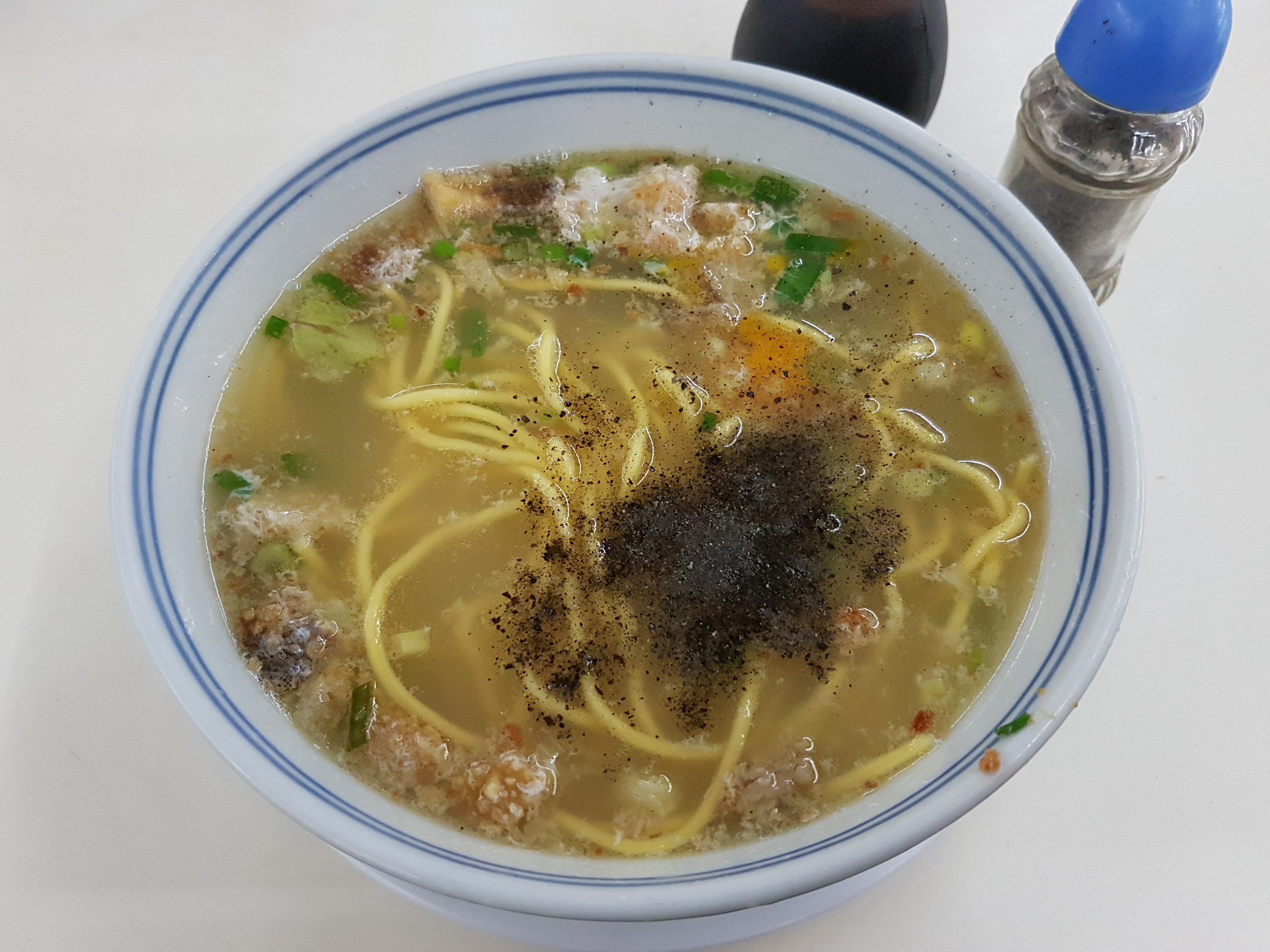 Iloilo is home of the ''batchoy'', derived from “ba-chui” meaning pieces of meat in Hokkien Chinese. The authentic ''batchoy'' contains fresh egg noodles called ''miki'', ''buto-buto'' broth slow-cooked for hours, and beef, pork and ''bulalo'' mixed with the local ''guinamos'' (shrimp paste). Toppings include generous amounts of fried garlic, crushed chicharon, scallions, slices of pork intestines and liver. Another type of pancit which is found in the said province is ''pancit Molo'', an adaptation of wonton soup and is a specialty of the town of Molo, a well-known district in Iloilo. Unlike other pancit, ''pancit Molo'' is not dry but soupy and it does not make use of long, thin noodles but instead wonton wrappers made from rice flour. Iloilo is also famous for its two ''Cajanus cajan, kadios'' or pigeon pea-based soups. The first is KBL or ''kadios baboy langka''. As the name implies, the three main ingredients of this dish are ''kadyos'', ''baboy'' (pork), and ''langka'' (unripe jackfruit is used here). Another one is KMU or ''kadios manok ubad''. This dish is composed mainly of ''kadyos'', ''manok'' (preferably free range chicken called ''Bisaya nga manok'' in Iloilo), and ''ubad'' (thinly cut white core of the banana stalk/trunk). Both of these dishes utilize another Ilonggo ingredient as a souring agent. This ingredient is ''batwan'', or ''Garcinia binucao'', a fruit closely related to mangosteen, which is very popular in Western Visayas and neighbouring Negros Island, but is generally unknown to other parts of the Philippines.
Roxas, Capiz, Roxas City is another food destination in Western Visayas aside from Iloilo City and Kalibo. This coastal city, about two to three hours by bus from Iloilo City, prides itself as the "Seafood Capital of the Philippines" due to its bountiful rivers, estuaries and seas. Numerous seafood dishes are served in the city's Baybay area such as mussels, oysters, scallops, prawns, seaweeds, clams, fishes and many more.
Cebu is known for its lechón variant. Lechon prepared "Cebu style" is characterized by a crisp outer skin and a moist juicy meat with a unique taste given by a blend of spices. Cebu is also known for sweets like dried mangoes and caramel tarts.
In Bohol, ''kalamay'' is popular. In Palawan, crocodile meat is boiled, cured, and turned into ''tocinos''. In Romblon, a specialty dish is pounded and flavored shrimp meat and rice cooked inside banana leaves.
Iloilo is home of the ''batchoy'', derived from “ba-chui” meaning pieces of meat in Hokkien Chinese. The authentic ''batchoy'' contains fresh egg noodles called ''miki'', ''buto-buto'' broth slow-cooked for hours, and beef, pork and ''bulalo'' mixed with the local ''guinamos'' (shrimp paste). Toppings include generous amounts of fried garlic, crushed chicharon, scallions, slices of pork intestines and liver. Another type of pancit which is found in the said province is ''pancit Molo'', an adaptation of wonton soup and is a specialty of the town of Molo, a well-known district in Iloilo. Unlike other pancit, ''pancit Molo'' is not dry but soupy and it does not make use of long, thin noodles but instead wonton wrappers made from rice flour. Iloilo is also famous for its two ''Cajanus cajan, kadios'' or pigeon pea-based soups. The first is KBL or ''kadios baboy langka''. As the name implies, the three main ingredients of this dish are ''kadyos'', ''baboy'' (pork), and ''langka'' (unripe jackfruit is used here). Another one is KMU or ''kadios manok ubad''. This dish is composed mainly of ''kadyos'', ''manok'' (preferably free range chicken called ''Bisaya nga manok'' in Iloilo), and ''ubad'' (thinly cut white core of the banana stalk/trunk). Both of these dishes utilize another Ilonggo ingredient as a souring agent. This ingredient is ''batwan'', or ''Garcinia binucao'', a fruit closely related to mangosteen, which is very popular in Western Visayas and neighbouring Negros Island, but is generally unknown to other parts of the Philippines.
Roxas, Capiz, Roxas City is another food destination in Western Visayas aside from Iloilo City and Kalibo. This coastal city, about two to three hours by bus from Iloilo City, prides itself as the "Seafood Capital of the Philippines" due to its bountiful rivers, estuaries and seas. Numerous seafood dishes are served in the city's Baybay area such as mussels, oysters, scallops, prawns, seaweeds, clams, fishes and many more.
Cebu is known for its lechón variant. Lechon prepared "Cebu style" is characterized by a crisp outer skin and a moist juicy meat with a unique taste given by a blend of spices. Cebu is also known for sweets like dried mangoes and caramel tarts.
In Bohol, ''kalamay'' is popular. In Palawan, crocodile meat is boiled, cured, and turned into ''tocinos''. In Romblon, a specialty dish is pounded and flavored shrimp meat and rice cooked inside banana leaves.
Mindanaoan cuisine

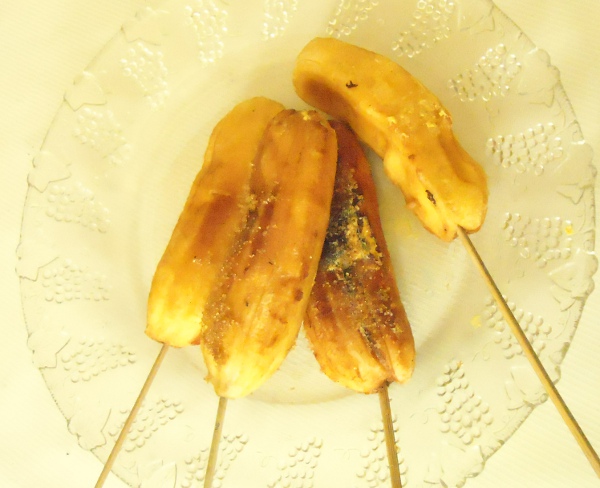 In
In Other food
Street food and other snacks

 Aside from pastries and desserts, there are heartier snacks for ''merienda'' that can also serve as either an appetizer or side dish for a meal. ''Siomai'' is the local version'' of Chinese shaomai.''
''Lumpia'' are spring rolls that can be either fresh or fried. Fresh ''lumpia'' (''lumpiang sariwa'') is usually made for fiestas or special occasions as it can be labor-intensive to prepare, while one version of fried ''lumpia'' (''lumpiang prito''), ''lumpiang shanghai'' is usually filled with ground pork and a combination of vegetables, and served with a sweet and sour dipping sauce. Other variations are filled with minced pork and shrimp and accompanied by a vinegar-based dipping sauce. ''Lumpia'' has been commercialized in frozen food form. Also, one of the common street food would be the Pares (food), Beef Pares in Manila. While Middle-Eastern food such as the Shawarma became popular in the Philippines in the late 1980s.
There's a distinct range of street foods available in the Philippines. Some of these are skewered on sticks in the manner of a kebab. One such example is ''banana-cue'' which is a whole banana or Plantain (cooking), plantain skewered on a short thin bamboo stick, rolled in brown sugar, and pan-fried. ''Kamote-cue'' is a peeled sweet potato skewered on a stick, covered in brown sugar and then pan-fried. Fish balls or Fishballs, squid balls including Calamares are also pan-fried, then skewered on bamboo sticks and given to the customer, who then has a choice of dipping in a sweet or savory sauce. These are commonly sold frozen in markets and peddled by Hawker (trade), street vendors. One of the more common habit of street vendors in Metro Manila carry out or yell the phrase, "Hopia, Mani, Popcorn at Vicks..".
''Turon (food), Turon'', a kind of '' lumpia'' consisting of an eggroll or phyllo wrapper commonly filled with sliced Plantain (cooking), plantain and occasionally jackfruit, is fried and sprinkled with sugar.
Aside from pastries and desserts, there are heartier snacks for ''merienda'' that can also serve as either an appetizer or side dish for a meal. ''Siomai'' is the local version'' of Chinese shaomai.''
''Lumpia'' are spring rolls that can be either fresh or fried. Fresh ''lumpia'' (''lumpiang sariwa'') is usually made for fiestas or special occasions as it can be labor-intensive to prepare, while one version of fried ''lumpia'' (''lumpiang prito''), ''lumpiang shanghai'' is usually filled with ground pork and a combination of vegetables, and served with a sweet and sour dipping sauce. Other variations are filled with minced pork and shrimp and accompanied by a vinegar-based dipping sauce. ''Lumpia'' has been commercialized in frozen food form. Also, one of the common street food would be the Pares (food), Beef Pares in Manila. While Middle-Eastern food such as the Shawarma became popular in the Philippines in the late 1980s.
There's a distinct range of street foods available in the Philippines. Some of these are skewered on sticks in the manner of a kebab. One such example is ''banana-cue'' which is a whole banana or Plantain (cooking), plantain skewered on a short thin bamboo stick, rolled in brown sugar, and pan-fried. ''Kamote-cue'' is a peeled sweet potato skewered on a stick, covered in brown sugar and then pan-fried. Fish balls or Fishballs, squid balls including Calamares are also pan-fried, then skewered on bamboo sticks and given to the customer, who then has a choice of dipping in a sweet or savory sauce. These are commonly sold frozen in markets and peddled by Hawker (trade), street vendors. One of the more common habit of street vendors in Metro Manila carry out or yell the phrase, "Hopia, Mani, Popcorn at Vicks..".
''Turon (food), Turon'', a kind of '' lumpia'' consisting of an eggroll or phyllo wrapper commonly filled with sliced Plantain (cooking), plantain and occasionally jackfruit, is fried and sprinkled with sugar.
 Street food featuring eggs include ''kwek-kwek'' which are hard-boiled quail eggs dipped in orange-dyed batter and then deep fried similar to tempura. ''Tokneneng'' is a larger version of ''kwek-kwek'' using chicken or duck eggs. Another Filipino egg snack is ''Balut (egg), balut'', essentially a boiled pre-hatched poultry egg, usually duck or chicken. These fertilized eggs are allowed to develop until the embryo reaches a pre-determined size and are then boiled. They are consumed, usually along with vinegar and salt. There is also another egg item called ''penoy,'' which is basically hard-boiled unfertilized duck eggs that does not contain embryo. Like ''taho'', ''balut'' is advertised by street hawkers calling out their product.
''Okoy,'' also spelled as ''ukoy,'' is another batter-covered, deep-fried street food in the Philippines. Along with the batter, it normally includes bean sprouts, shredded pumpkin and very small shrimps, shells and all. It is commonly dipped in a combination of vinegar and chilli.
Among other street food are already mentioned #Pulutan, pulutan like ''isaw'', seasoned hog or chicken intestines skewered onto a stick and grilled; ''betamax'', roasted dried chicken blood cut into and served as small cubes, from which it received its name due to its crude resemblance to a Betamax tape; ''Adidas'', grilled chicken feet named after the popular shoe brand; and ''Proven (food), proven'', the proventriculus of a chicken coated in cornstarch and deep-fried. Fries made from sweet potatoes have also been dubbed "Pinoy fries". Most street foods are usually found near certain schools and universities, one example would be at Metro Manila's University Belt.
In addition to the Availability of the 24/7 burgers stands such as Burger Machine (nicknamed "the burger that never sleeps"), Angel's Burger, Franks N' Burgers and Minute Burger across the country.
Pagpag is leftover food from restaurants (usually from fast-food restaurants) scavenged from garbage sites and dumps, Pagpag food can also be expired frozen meat, fish, or vegetables discarded by supermarkets and scavenged in garbage trucks where this expired food is collected. eaten by the people suffering from the extreme poverty in the Philippines. Selling pagpag was a profitable business in areas where poor people live. Pagpag is basically more often than not food collected by homeless individuals in day's end from various fastfood local restaurants in the Philippines.
Street food featuring eggs include ''kwek-kwek'' which are hard-boiled quail eggs dipped in orange-dyed batter and then deep fried similar to tempura. ''Tokneneng'' is a larger version of ''kwek-kwek'' using chicken or duck eggs. Another Filipino egg snack is ''Balut (egg), balut'', essentially a boiled pre-hatched poultry egg, usually duck or chicken. These fertilized eggs are allowed to develop until the embryo reaches a pre-determined size and are then boiled. They are consumed, usually along with vinegar and salt. There is also another egg item called ''penoy,'' which is basically hard-boiled unfertilized duck eggs that does not contain embryo. Like ''taho'', ''balut'' is advertised by street hawkers calling out their product.
''Okoy,'' also spelled as ''ukoy,'' is another batter-covered, deep-fried street food in the Philippines. Along with the batter, it normally includes bean sprouts, shredded pumpkin and very small shrimps, shells and all. It is commonly dipped in a combination of vinegar and chilli.
Among other street food are already mentioned #Pulutan, pulutan like ''isaw'', seasoned hog or chicken intestines skewered onto a stick and grilled; ''betamax'', roasted dried chicken blood cut into and served as small cubes, from which it received its name due to its crude resemblance to a Betamax tape; ''Adidas'', grilled chicken feet named after the popular shoe brand; and ''Proven (food), proven'', the proventriculus of a chicken coated in cornstarch and deep-fried. Fries made from sweet potatoes have also been dubbed "Pinoy fries". Most street foods are usually found near certain schools and universities, one example would be at Metro Manila's University Belt.
In addition to the Availability of the 24/7 burgers stands such as Burger Machine (nicknamed "the burger that never sleeps"), Angel's Burger, Franks N' Burgers and Minute Burger across the country.
Pagpag is leftover food from restaurants (usually from fast-food restaurants) scavenged from garbage sites and dumps, Pagpag food can also be expired frozen meat, fish, or vegetables discarded by supermarkets and scavenged in garbage trucks where this expired food is collected. eaten by the people suffering from the extreme poverty in the Philippines. Selling pagpag was a profitable business in areas where poor people live. Pagpag is basically more often than not food collected by homeless individuals in day's end from various fastfood local restaurants in the Philippines.
Exotic dishes
Influences abroad
Filipino-American cuisine
Filipino-American cuisine was first brought over to and developed in the United States by History of Filipino Americans, Filipino immigrants in the early twentieth century, creating a distinct style of culinary traditions that were adapted to both the local availability of ingredients as well as American tastes. Many Filipino-owned restaurants and catering services can be found in various Filipino communities, also known as "Little Manila, Little Manilas", located all throughout the United States, primarily concentrated within densely populated cities like Los Angeles and New York City. Many family-owned and chef-owned restaurants in these communities introduced many staple dishes found in the Philippines to the United States, such as Inihaw, inihaw na liempo, Lumpiang Shanghai, lumpiang shanghai, adobo and kare-kare. Some modern Filipino-American restaurants have taken these traditional dishes and further adapted them for American tastes through variations in ingredients, preparation, and presentation with restaurants like Bad Saint in Washington D.C., Maharlika in New York, and Lasa in Los Angeles gaining mass popularity and praise for their speciality dishes. Cendrillion, opened in 1995 by Amy Besa and Romy Dorotan in New York, is seen as one of the first breakthrough Filipino-American restaurants that popularized Filipino cuisine with innovative, novel meals such as an adobo made with rabbit and quail or a crème brûlée flavored with ginger and lemongrass. Tom Cunanan, a James Beard Foundation Award, James Beard award-winning Filipino-American chef and founder of Bad Saint, also opened a restaurant named Pogiboy that further combines American and Filipino cuisine by serving dishes such as sinigang-flavored fried chicken and Vigan longganisa, longganisa and tocino-filled hamburgers. Another restaurant, Señor Sisig, located in the San Francisco area, serves an innovative combination of Filipino and Mexican food through brick-and-mortar restaurants and food trucks. By combining traditional Filipino ingredients and flavor profiles with Mexican dishes like burritos and nachos, Evan Kidera, one of the co-founders of Señor Sisig hopes to better introduce Filipino cuisine to the United States by fusing it with a more familiar cuisine to better suit American palates. Some of these Filipino-American restaurants such as Barkada, Jeepney, Pogiboy and Maharlika have also introduced the ''kamayan'' feast to American diners, a traditional way of eating a variety of Filipino dishes served communal-style using ones hands. Popular Filipino restaurant chains such as Jollibee have also established themselves in the United States, subsequently developing a rapidly-growing fanbase and social media presence. Jollibee, a Filipino fast-food chain well known for their American-influenced food items such as fried chicken and hamburgers, currently has sixty-four franchises in the country with plans to open one hundred and fifty stores within the next five years. The chain also serves Filipino dishes like Pancit, pancit palabok, halo-halo, and an American-inspired peach-mango pie. Other restaurant chains such as Chowking, a Filipino-Chinese inspired fast-food chain, and Red Ribbon, a bakery serving Filipino desserts and baked goods have also opened up a smaller amount of various locations within the United States. Ube (yam), Ube, a purple yam traditionally used in many Filipino foods and desserts, has also seen a surge in popularity in the United States as a cooking ingredient in recent years. Traditionally served in desserts such as ube halaya or halo-halo, it can be seen served in a variety of American restaurants and foods (typically desserts) including waffles, coffee cakes, cupcakes, and in doughnuts as well. Ube has also seen popularity as a flavor of beer in American breweries in the states of California and Hawaii. Trader Joe's, an American grocery store chain, also sells ube-flavored ice cream, pancake mix, and shortbread cookies.Filipino-Chinese cuisine
See also
* List of Philippine desserts * List of Philippine dishes * List of restaurant chains in the Philippines * Philippine condiments * Filipino-American cuisine * Indonesian cuisine * Thai cuisineReferences
Further reading
''Kulinarya – A Guidebook to Philippine Cuisine''
(Michaela Fenix, Ed.). Manila: Asia Society. . * Bernardino, Minnie. (September 27, 1990)
"Breakfast – 8 Places Off the Beaten-Egg Track – Ethnic fare: Breakfast is many things to many peoples, as L.A.'s restaurants prove. A sampling from the variety available to a.m. adventurers. – Filipino"
''Los Angeles Times''. * Bayhon-Yrastorza, Caren. (December 16, 2010)
Recipe: Chicken relleno for Noche Buena
ABS-CBN News. Retrieved December 24, 2010.
Classic, fail-safe 'Noche Buena' recipes
(December 24, 2009). ABS-CBN News. Retrieved December 24, 2010. * Alan Davidson (food writer), Davidson, Alan and Tom Jaine. (2006)
''The Oxford Companion to Food''
(2nd ed.). New York: Oxford University Press. pp
600–601
. * * * Doreen Fernandez, Fernandez, Doreen. (1988)
"Culture Ingested: On the Indigenization of Philippine Food"
In E.N. Alegre & D. G. Fernandez (Eds.) ''Sarap: Essays on Philippine Food''. Manila: Mr. & Ms. Publishing Company, Inc. Retrieved 2010-08-02. * * Gelle, Gerry G. (2008). ''Filipino Cuisine: Recipes from the Islands'' (3rd ed.). Museum of New Mexico Press. . * * * * Orosa, Maria Y. and Helen Orosa del Rosario. (1970). ''Maria Y. Orosa, Her Life and Work'' (Helen Orosa del Rosario, Ed.). [Quezon City:] R. P. Garcia Pub. Co.
Philippine Cuisine
(n.d.). ''Tagalog at NIU''. Retrieved 2011-01-17 from the Northern Illinois University, Center for Southeast Asian Studies, SEAsite Project. * * * * * * *
External links
* * {{DEFAULTSORT:Philippine Cuisine Philippine cuisine, Southeast Asian cuisine